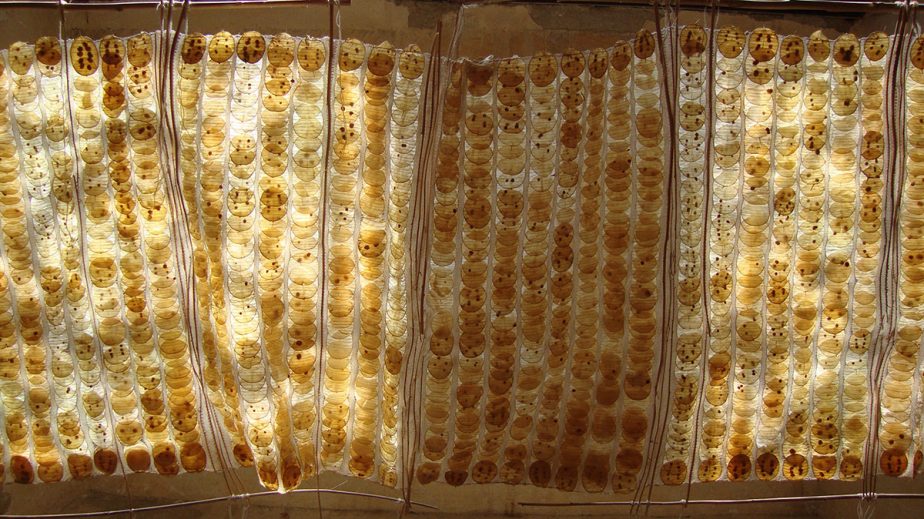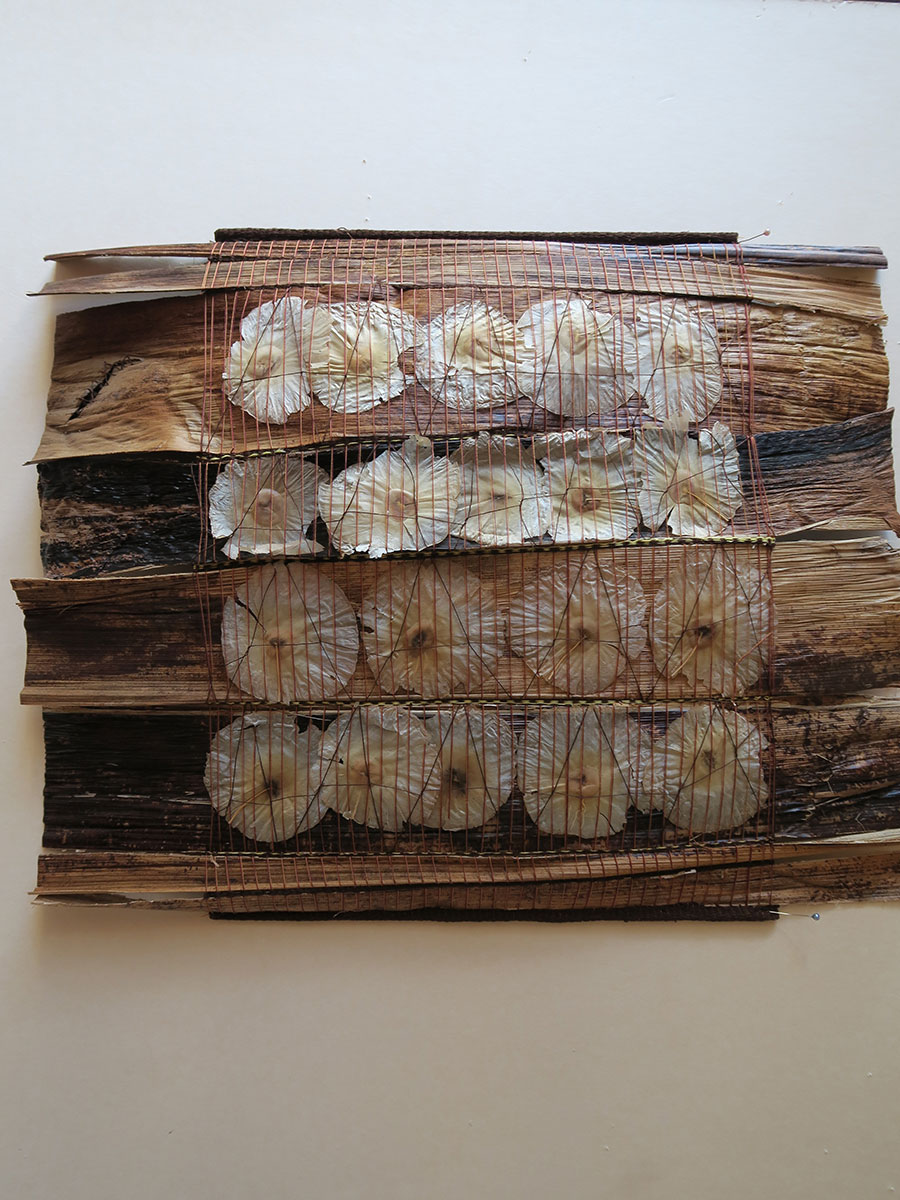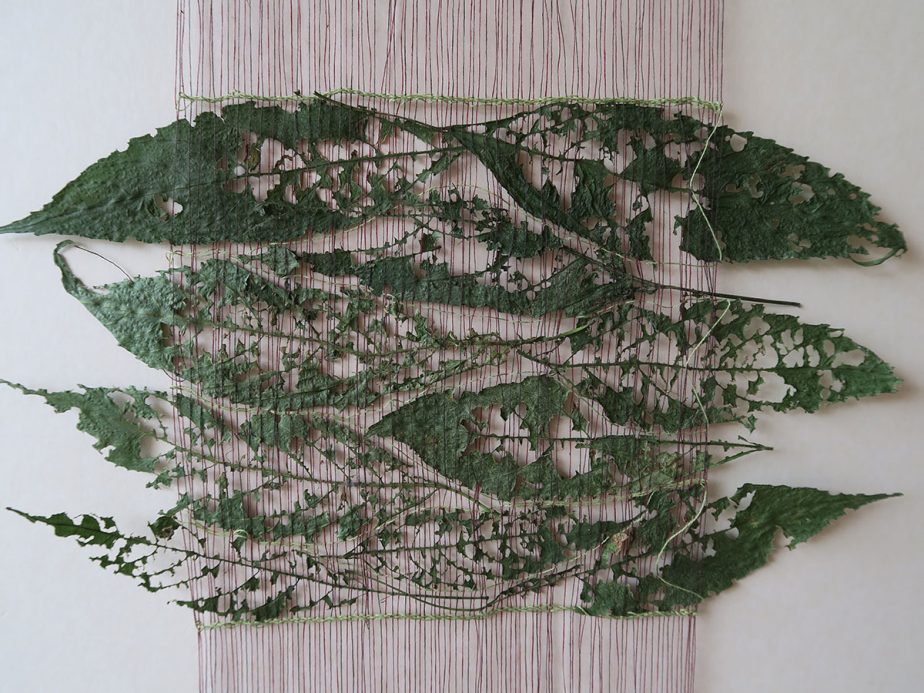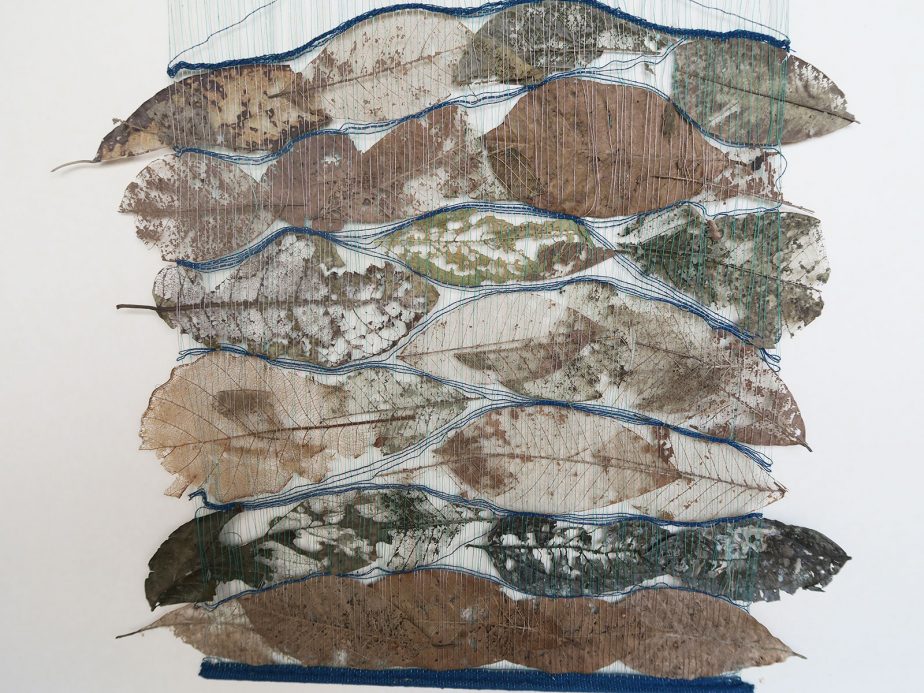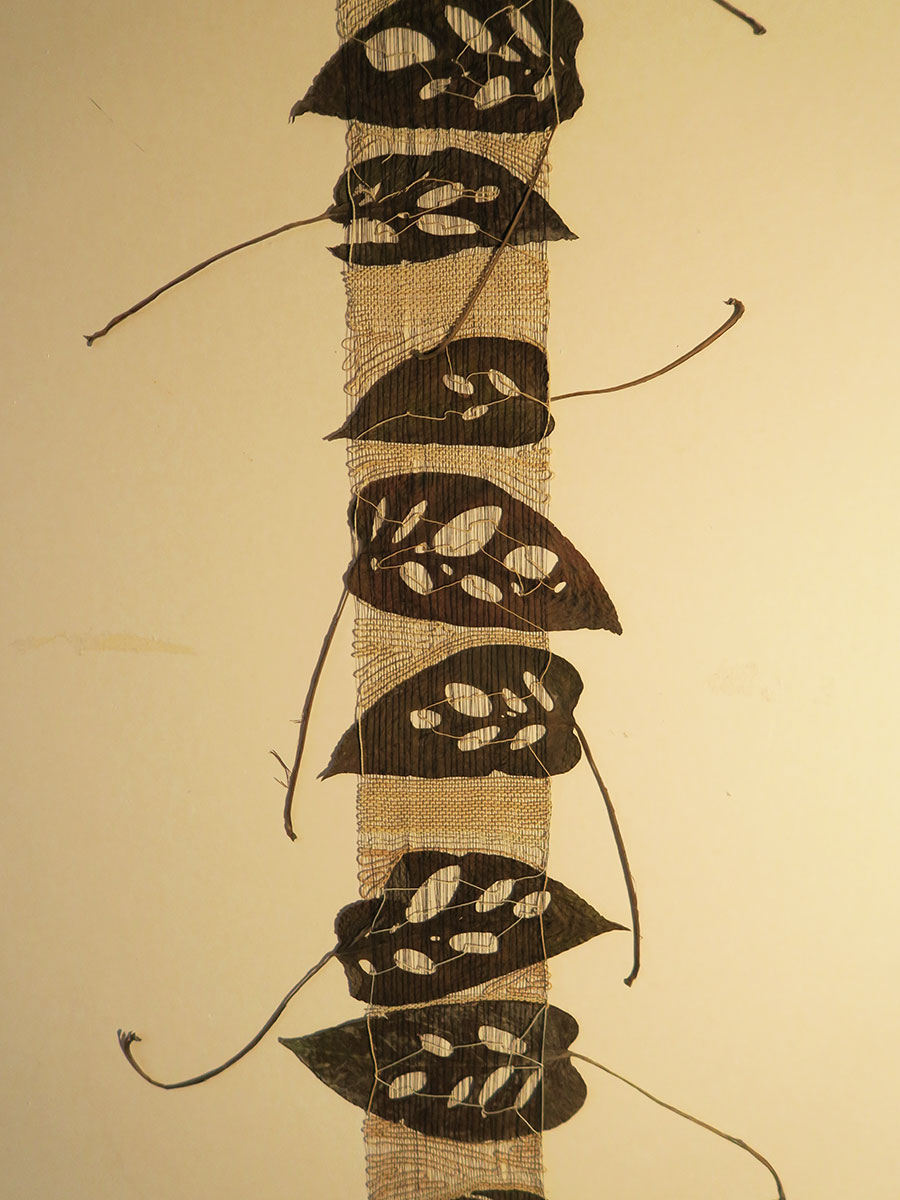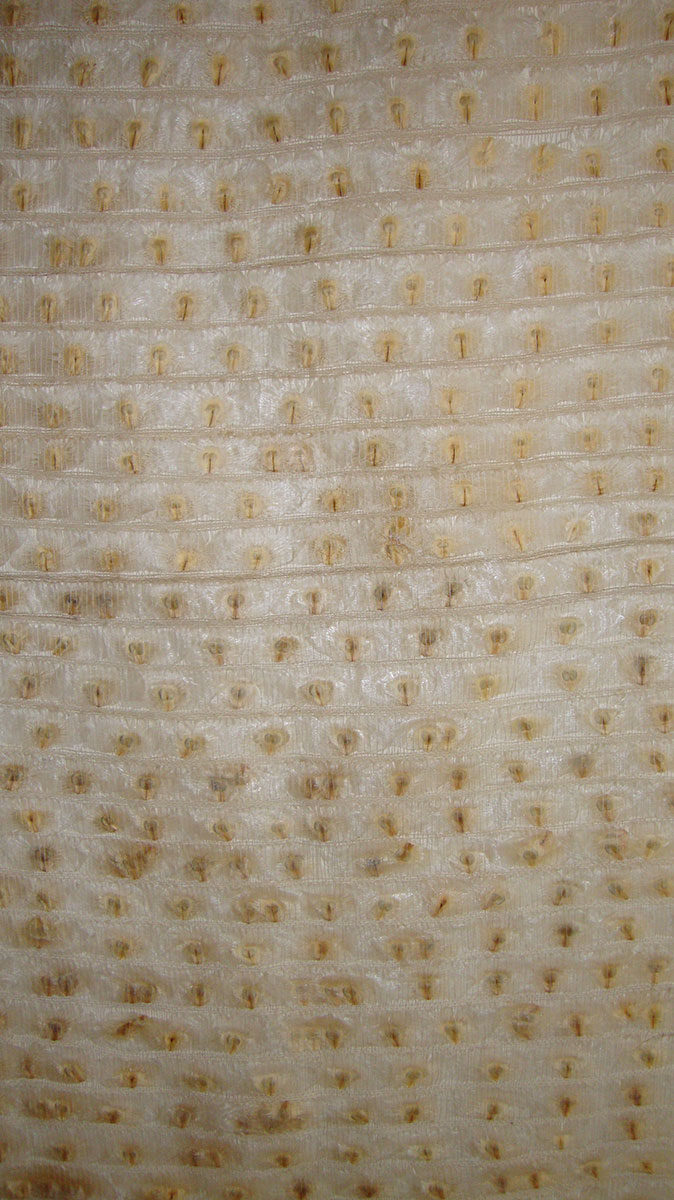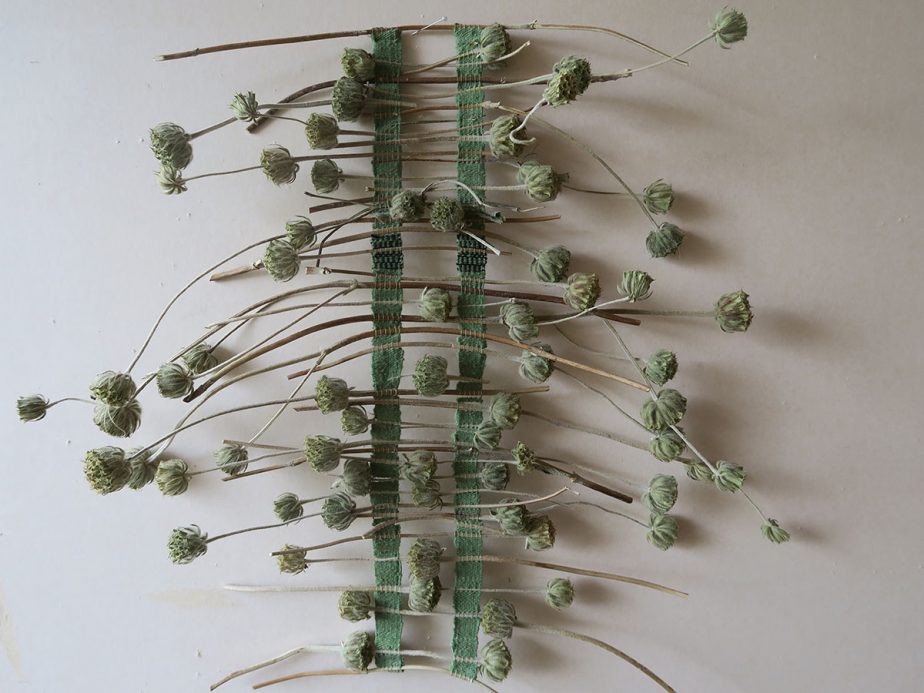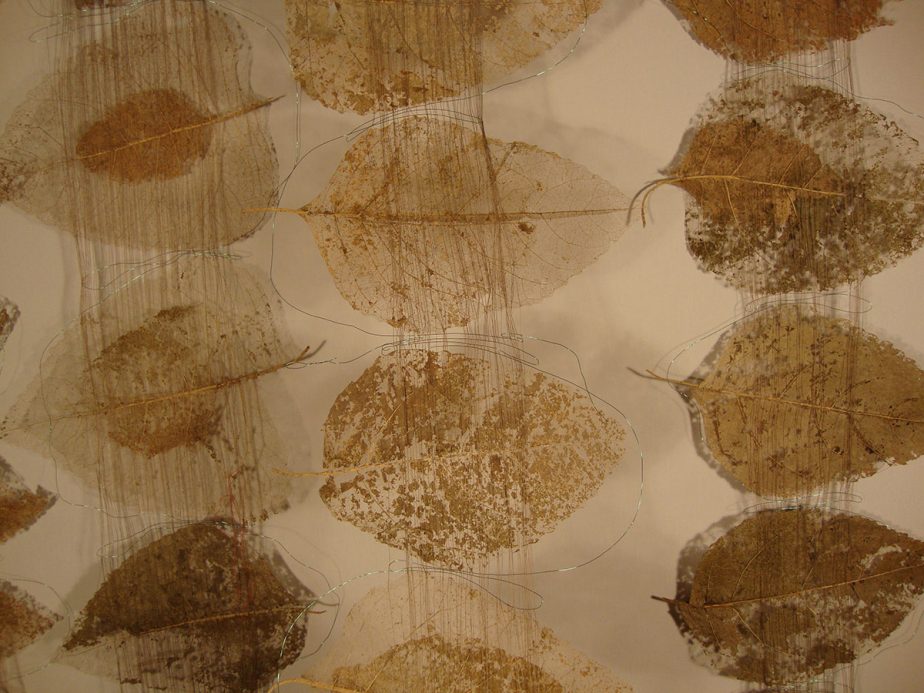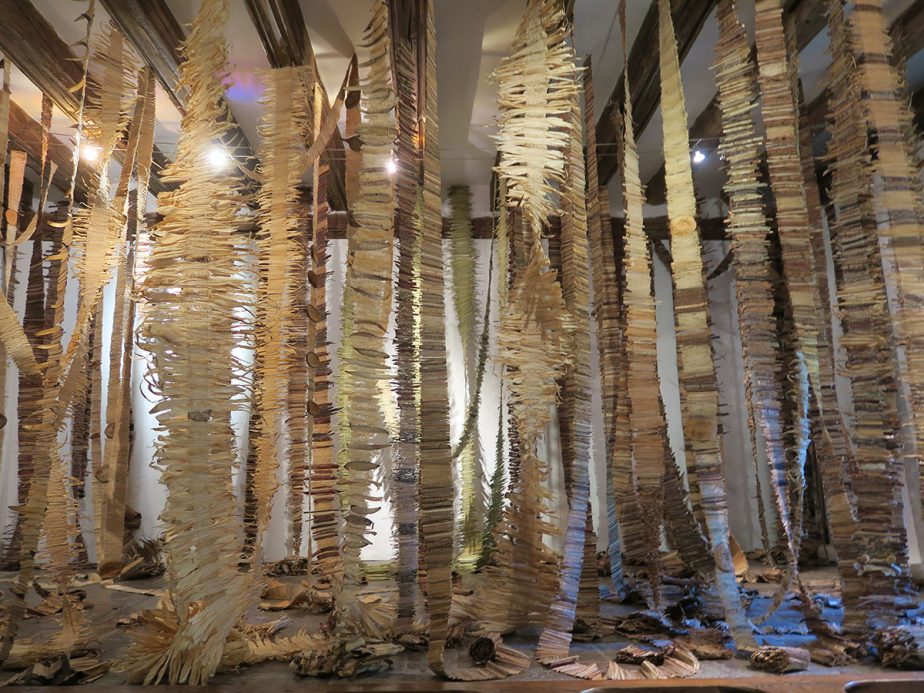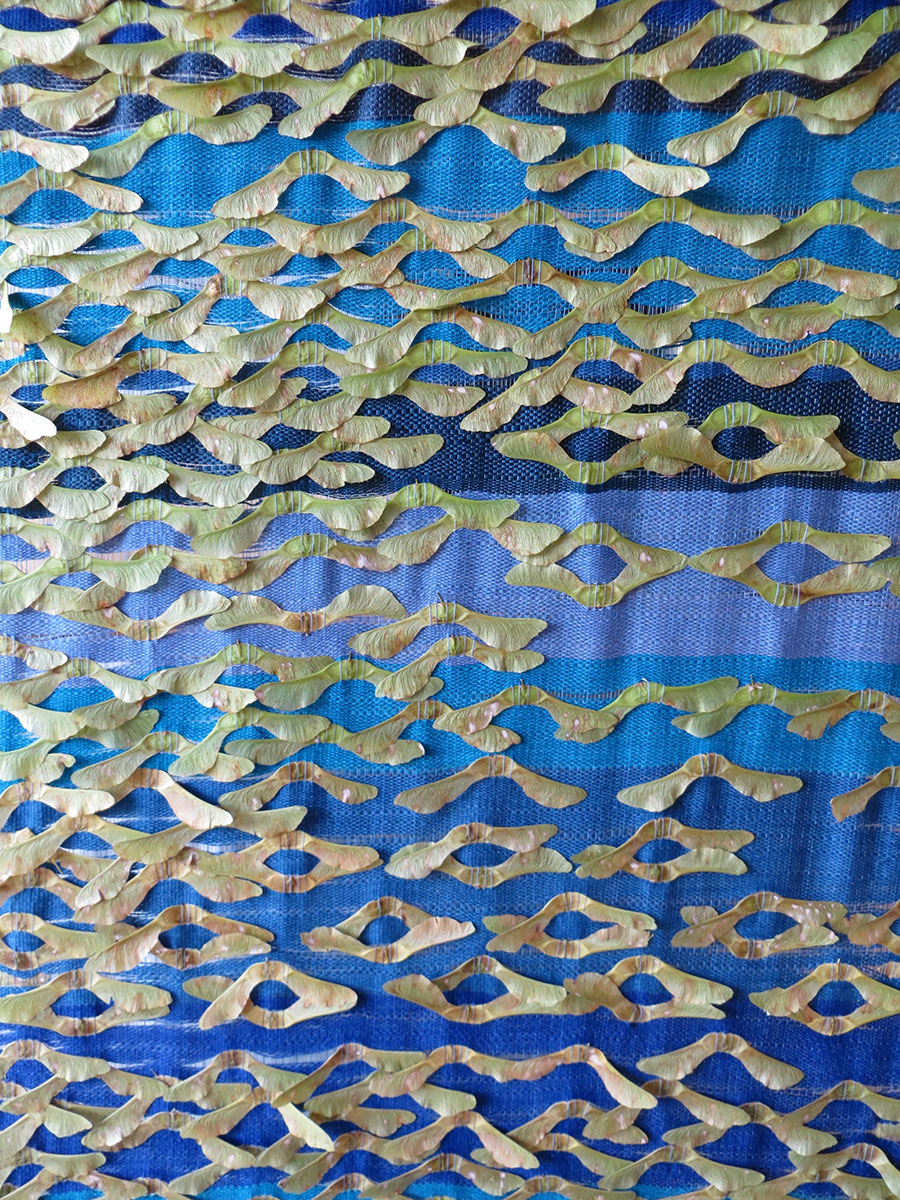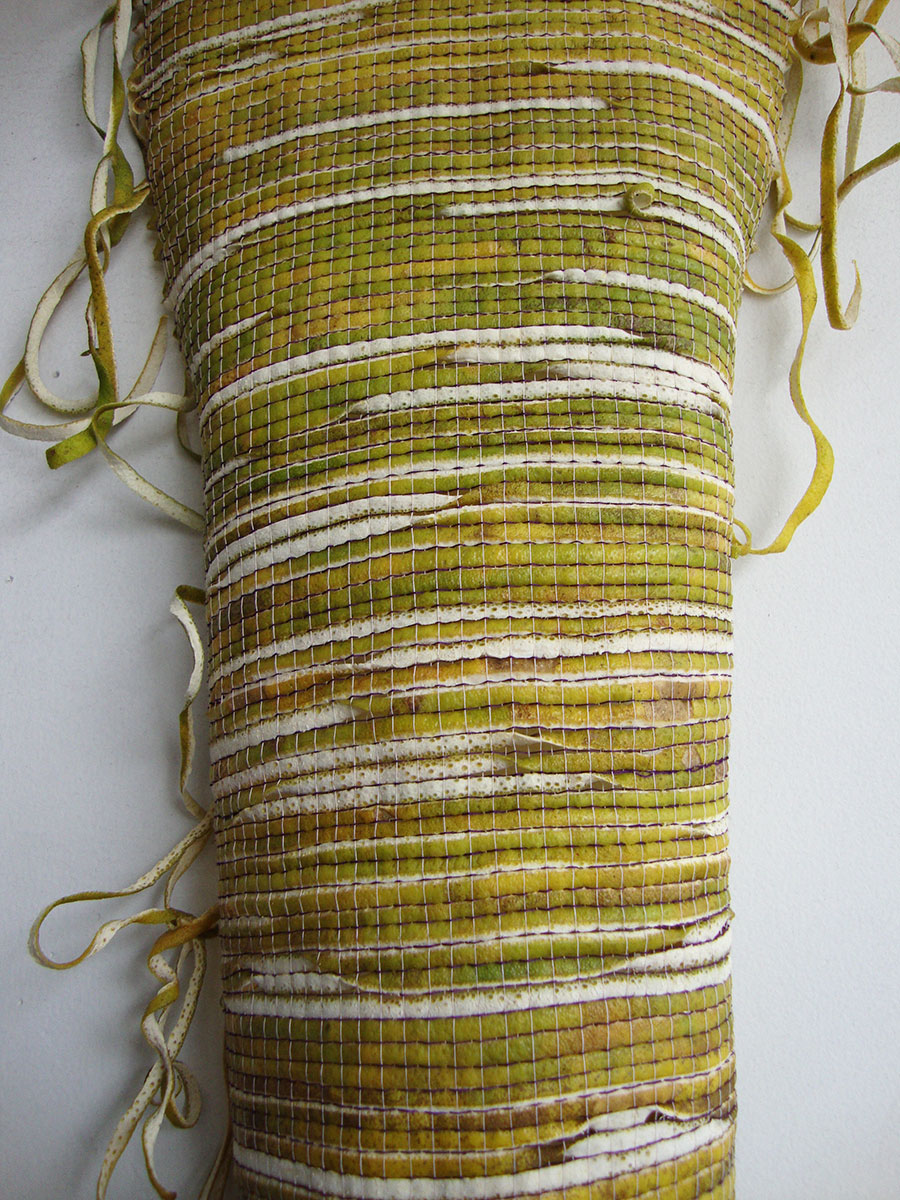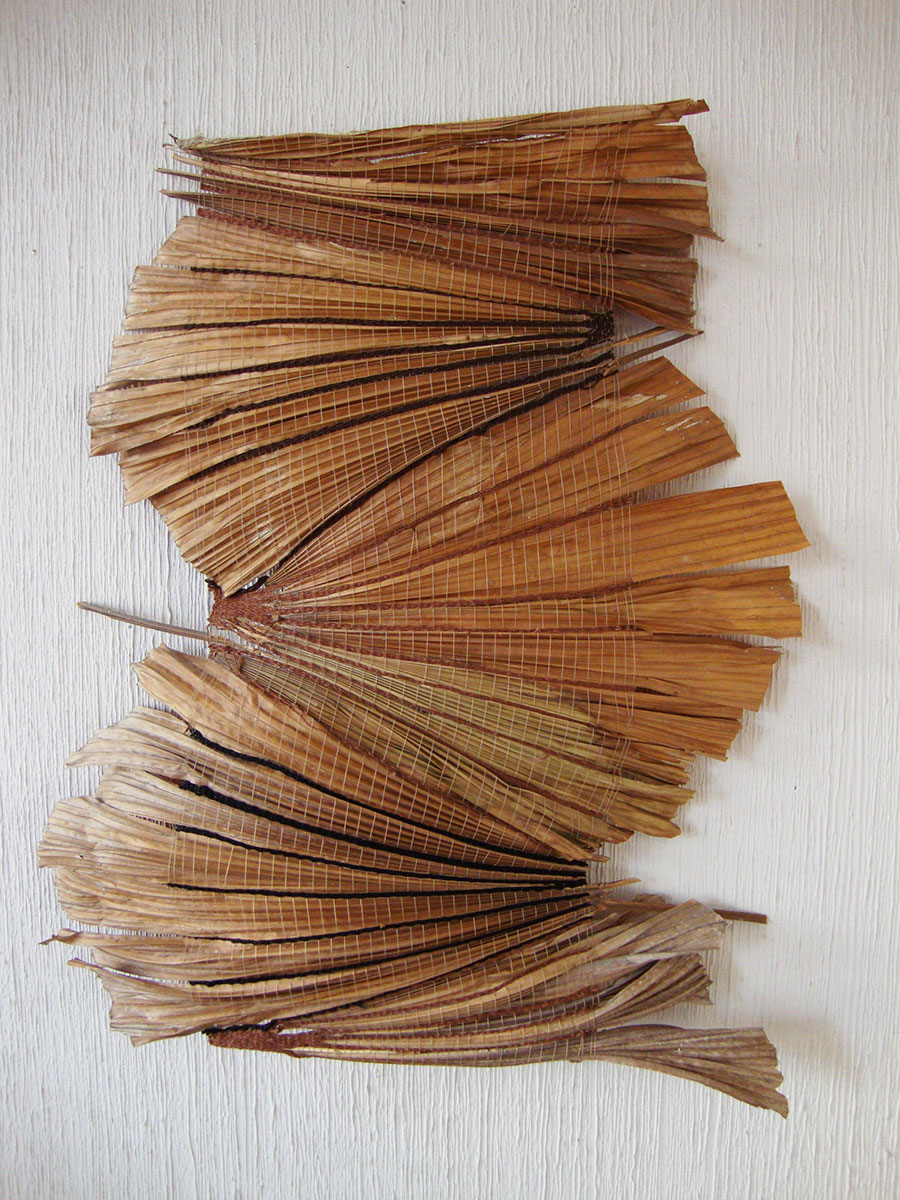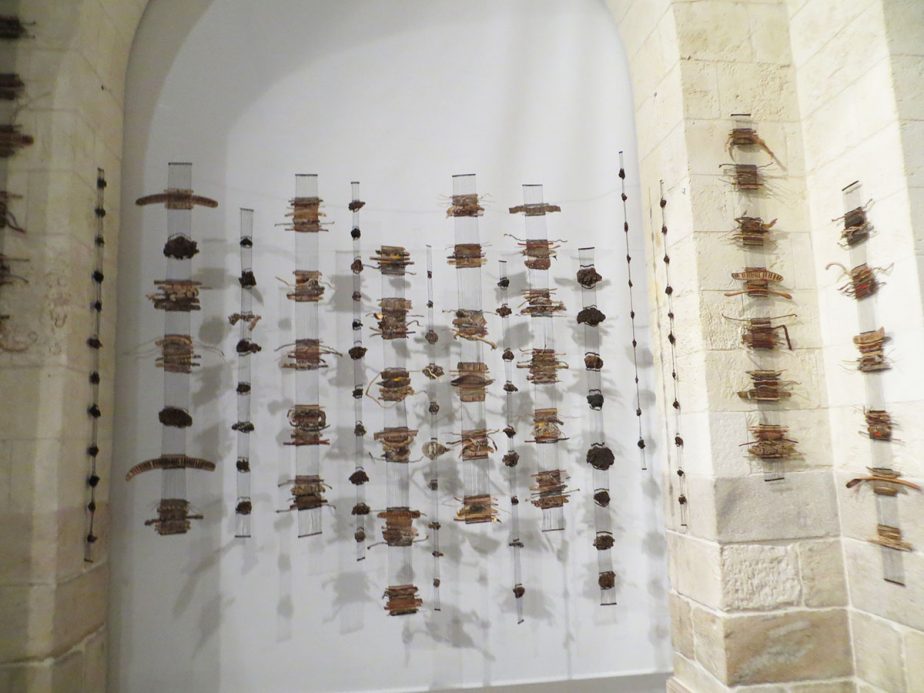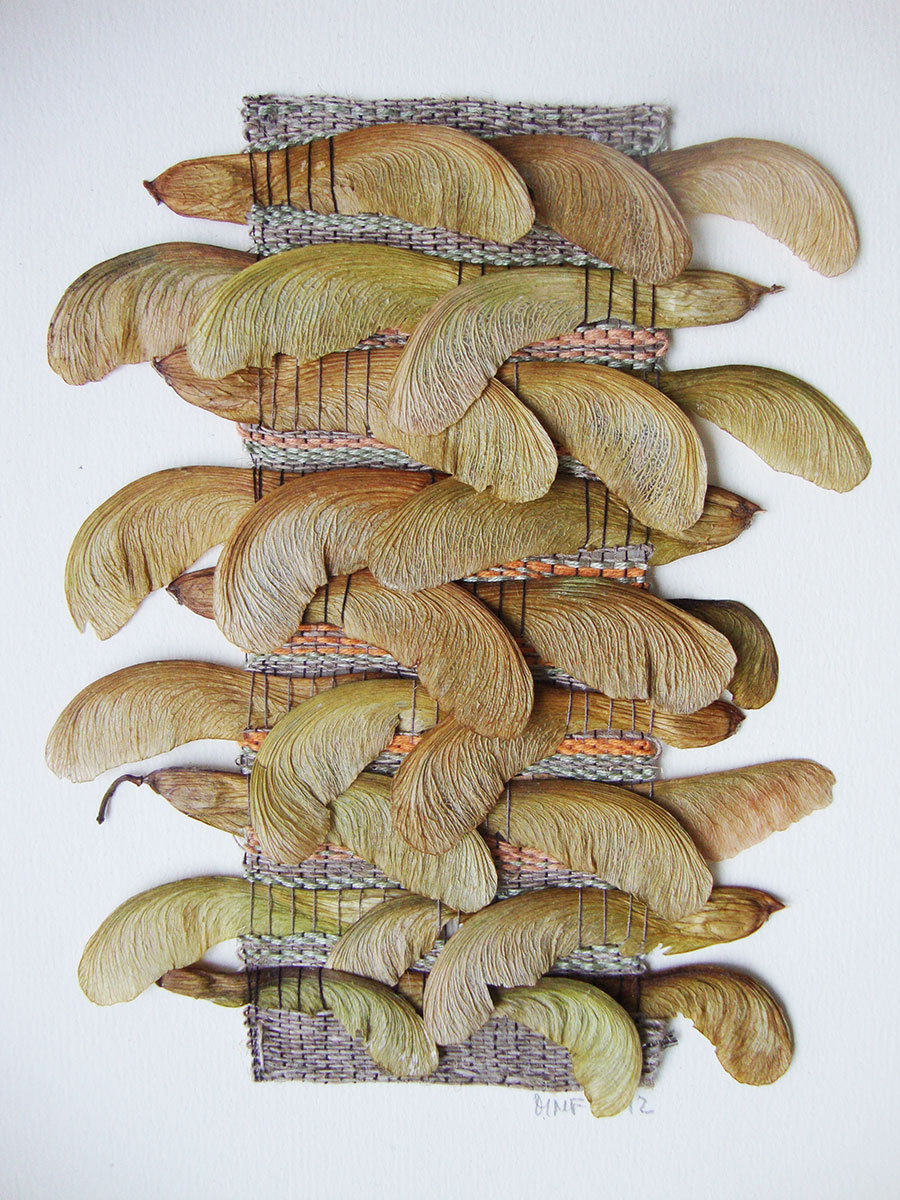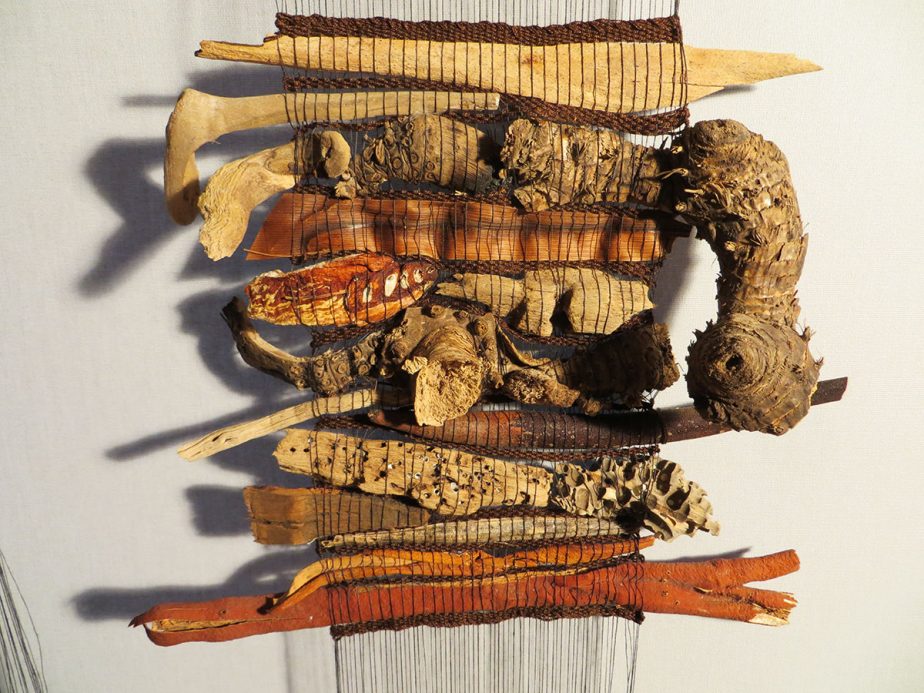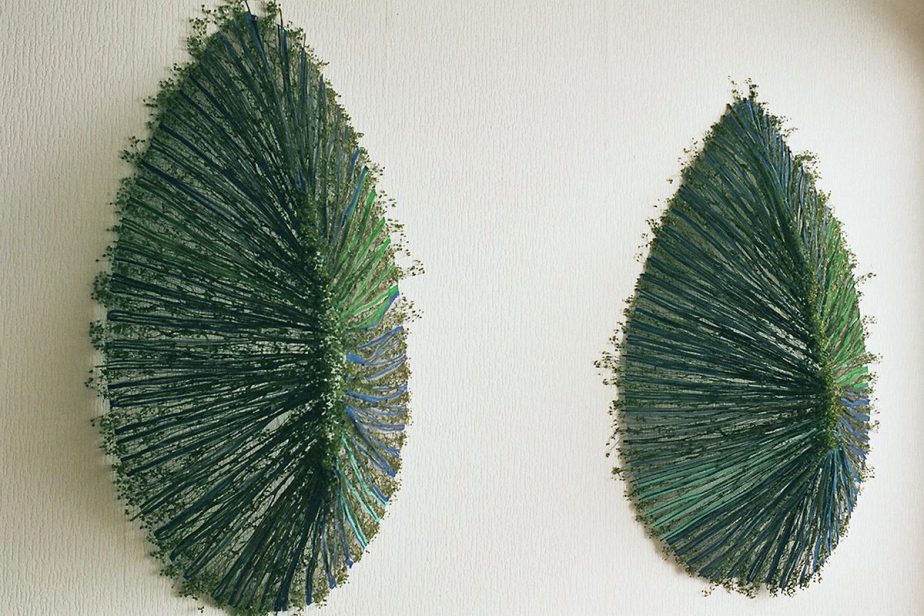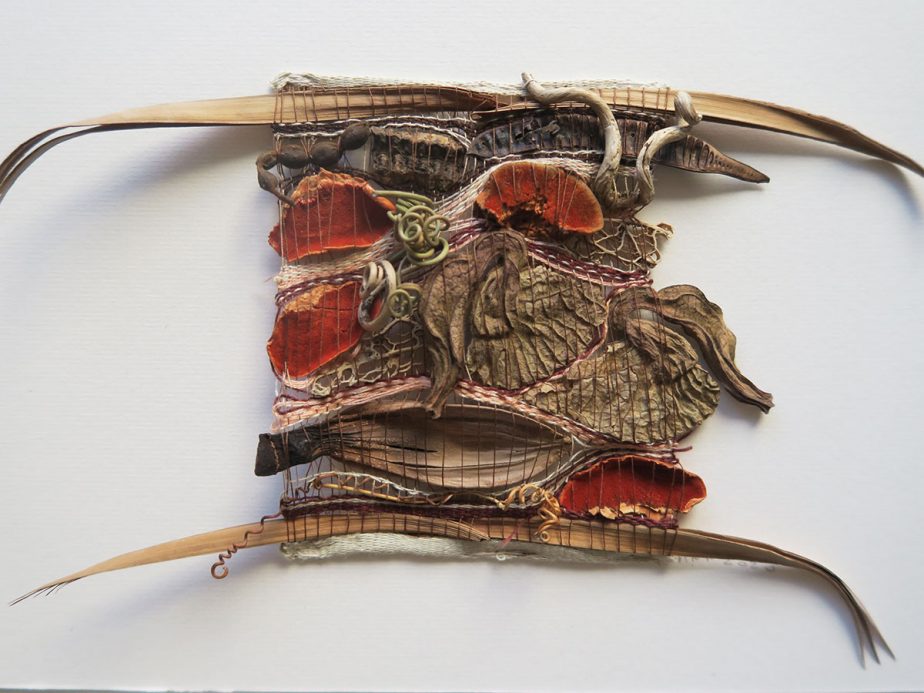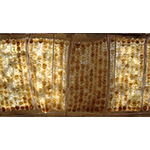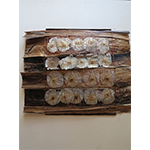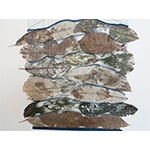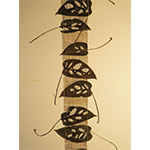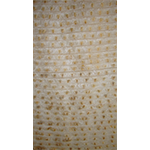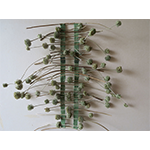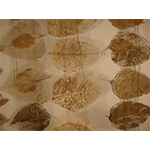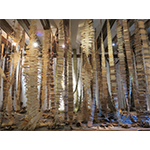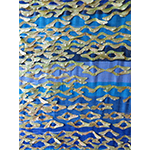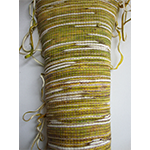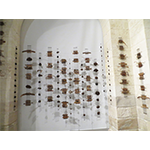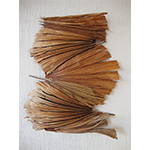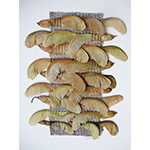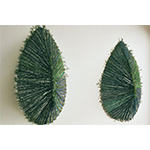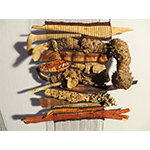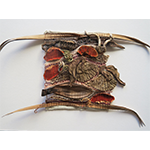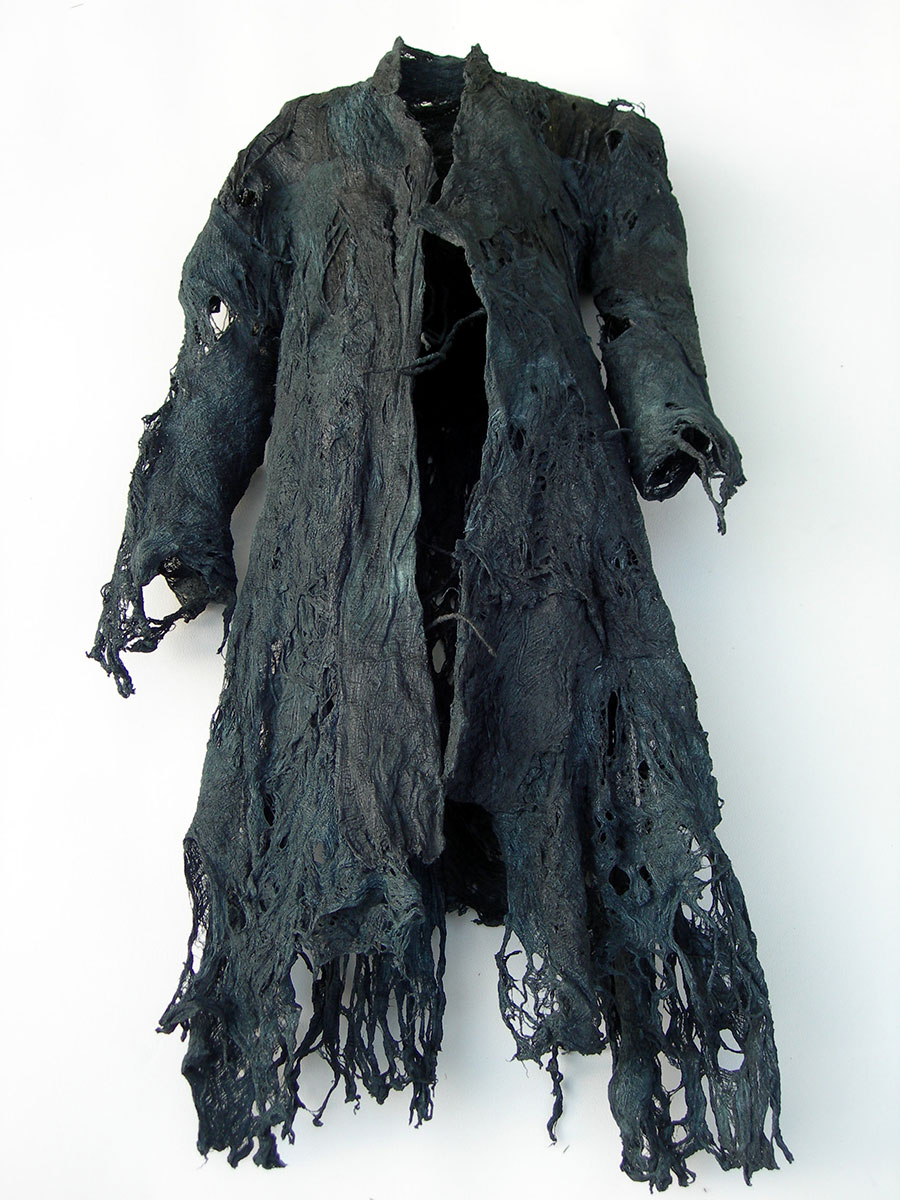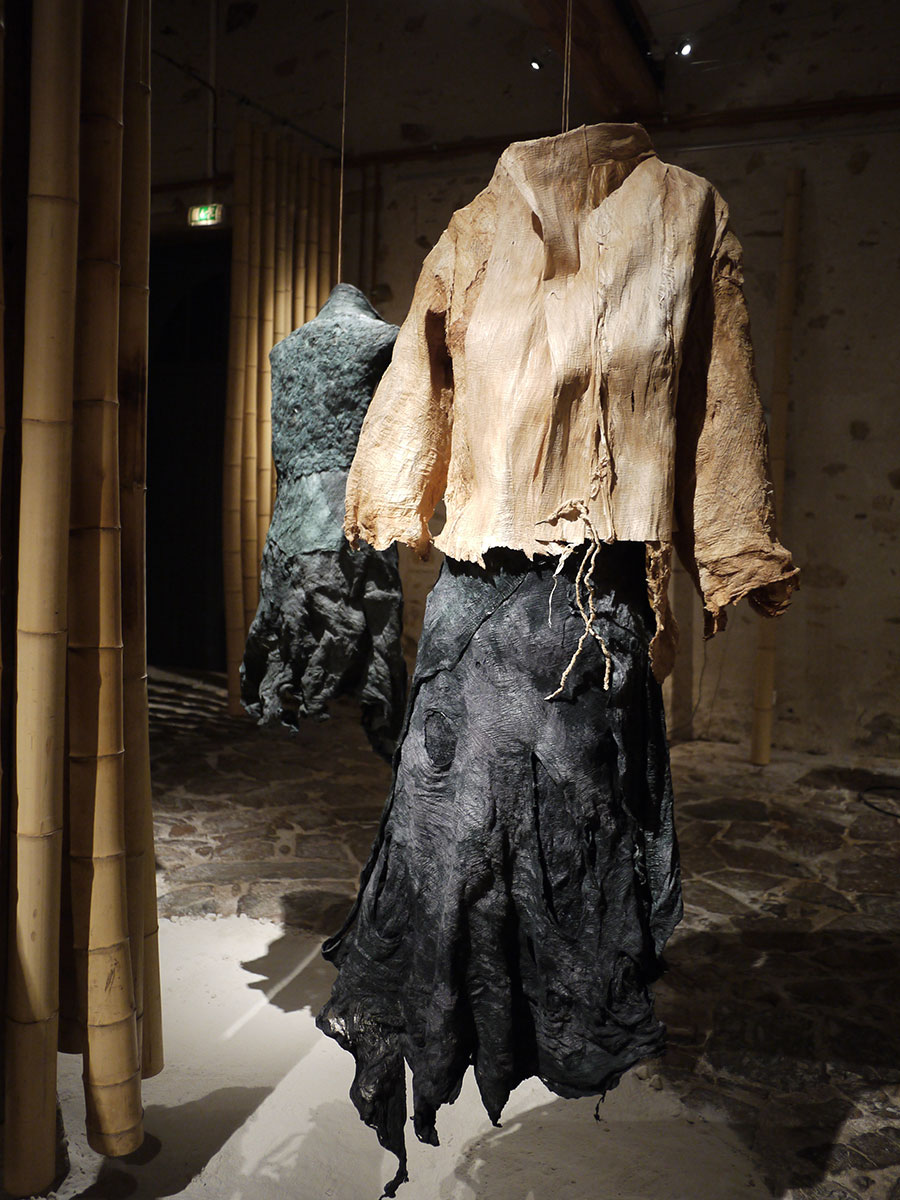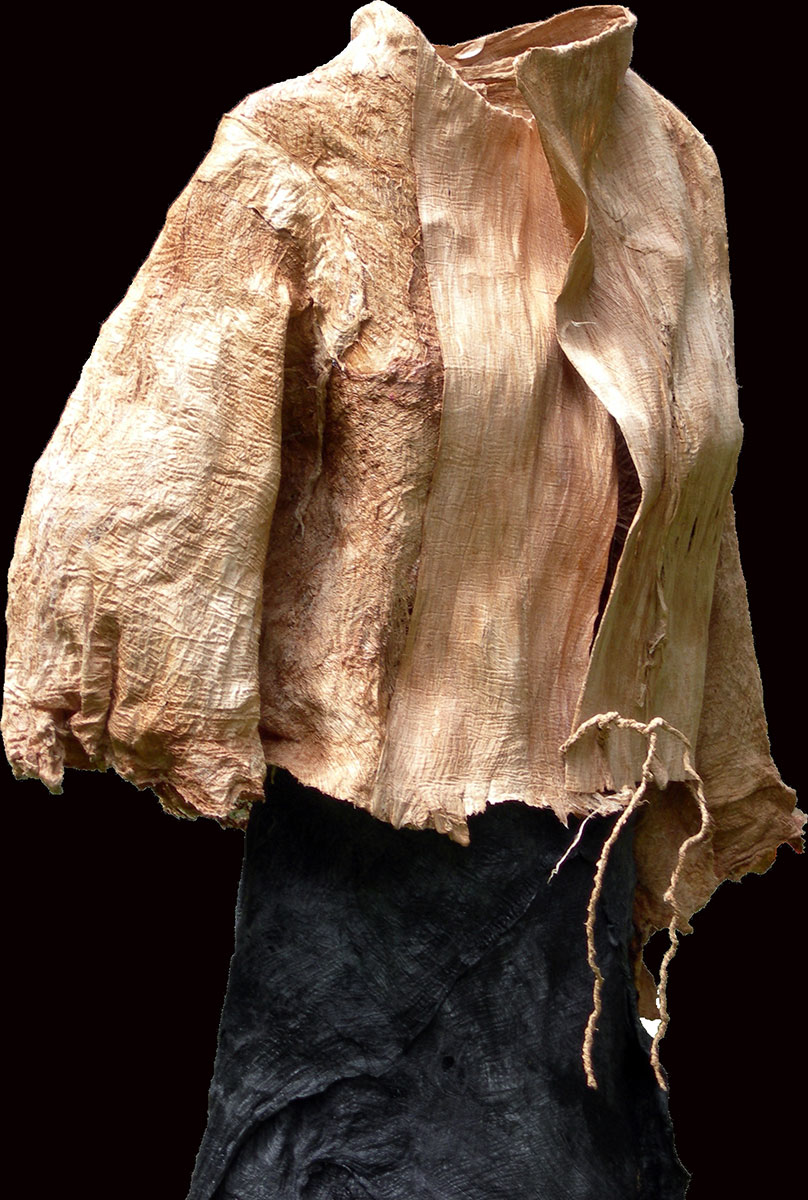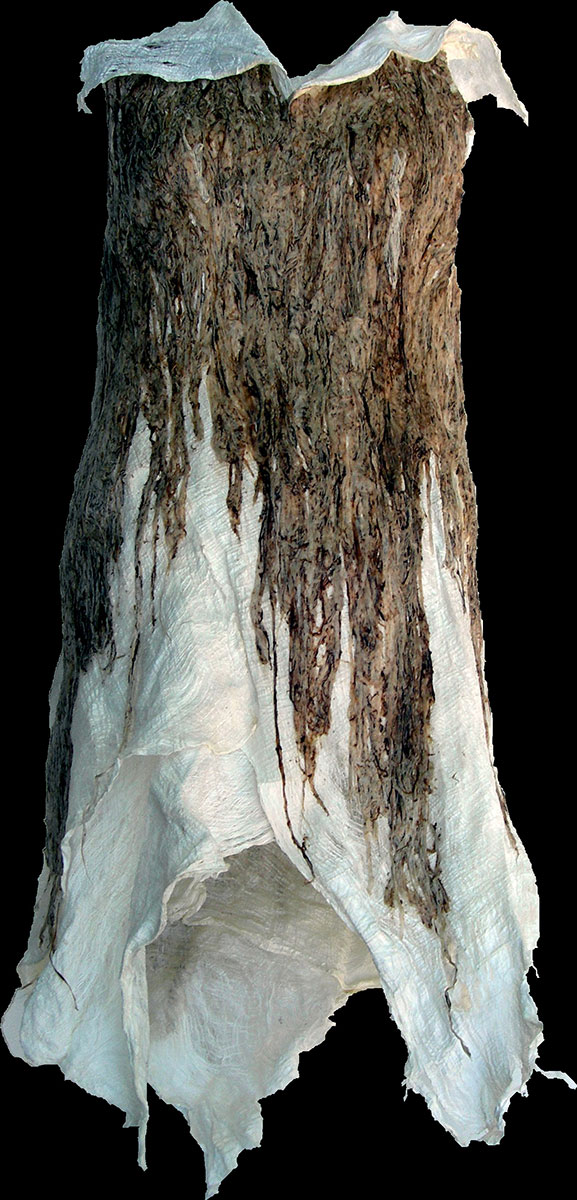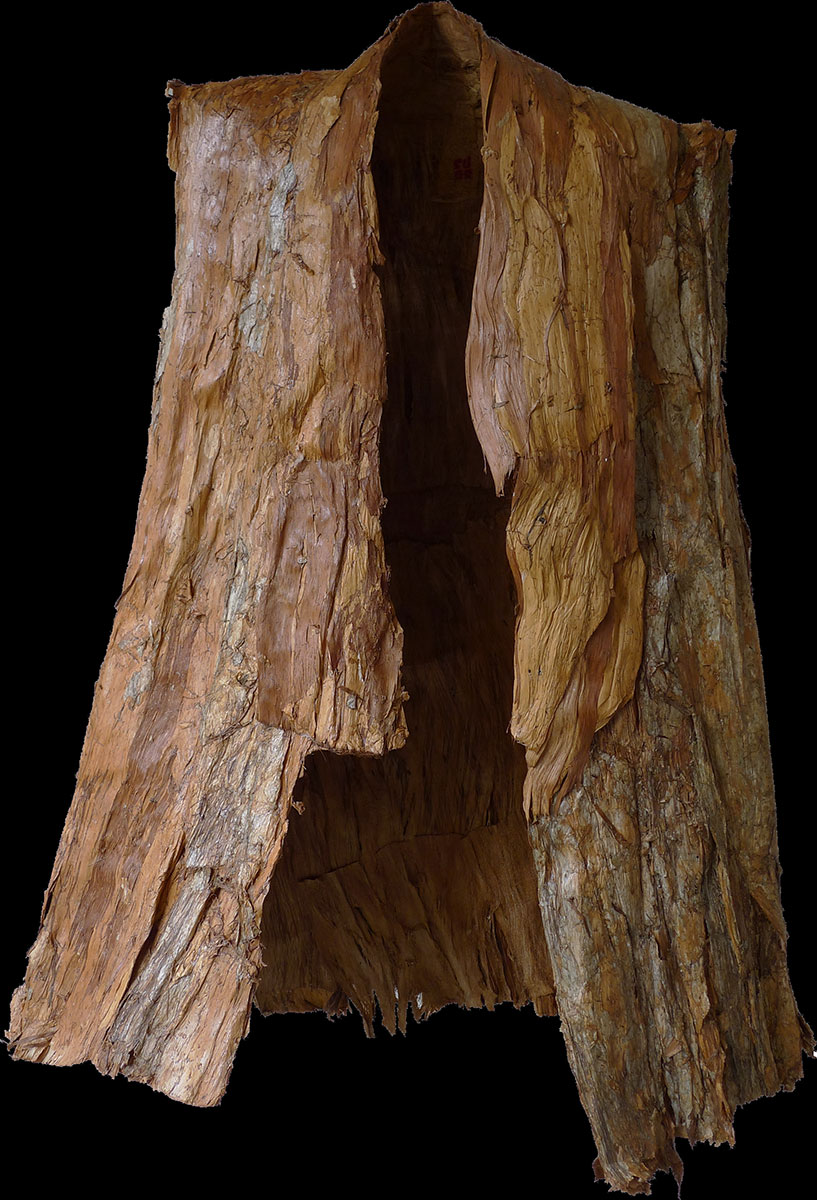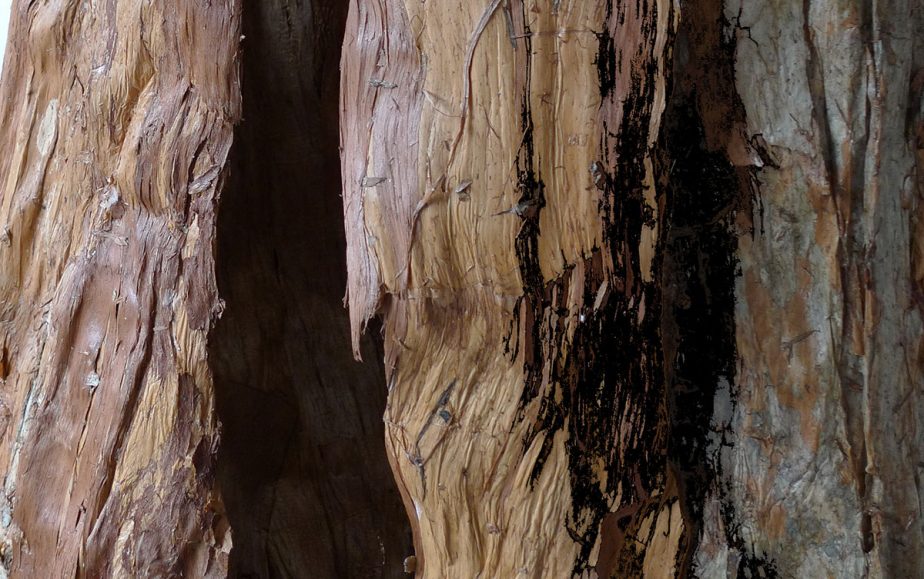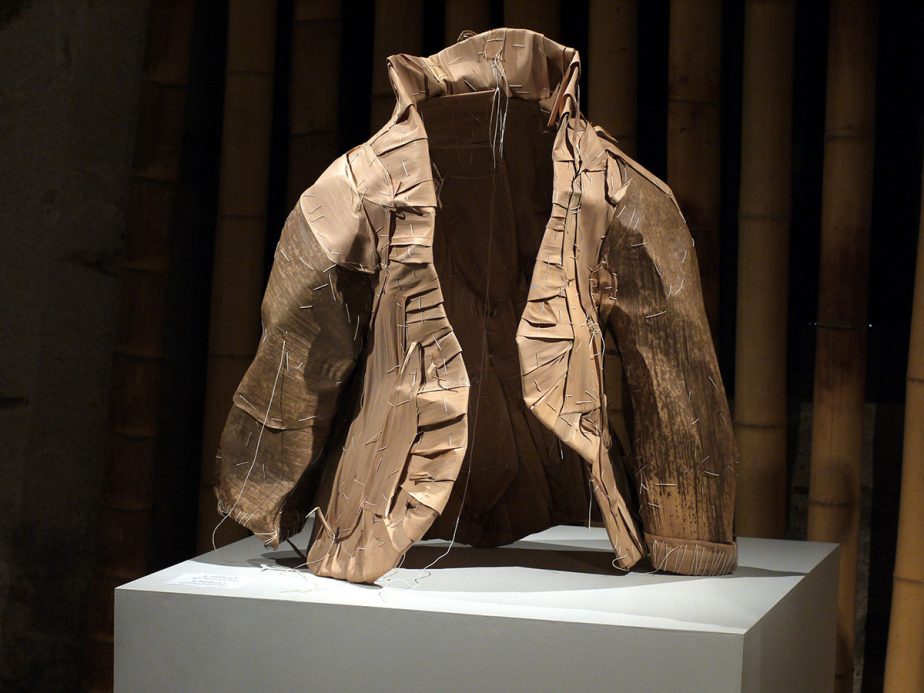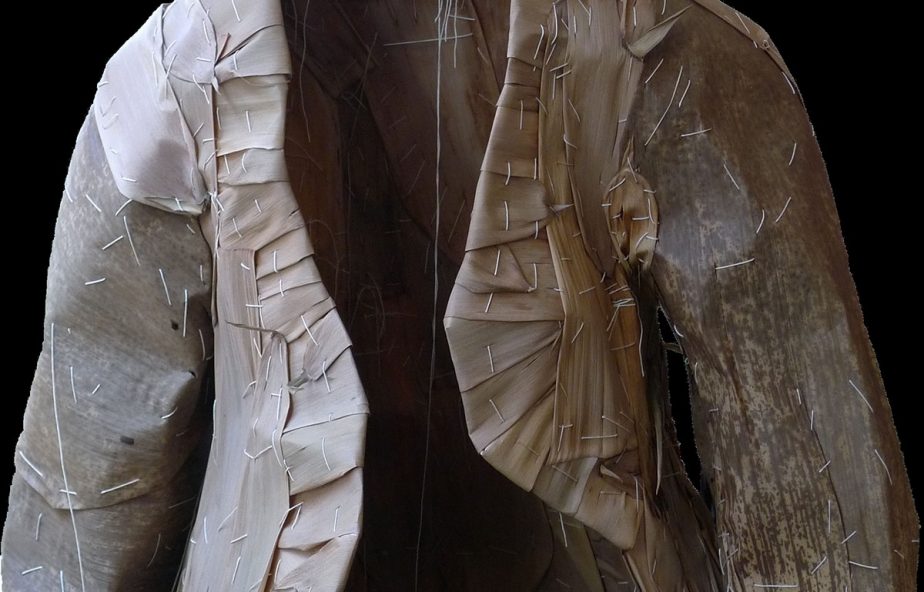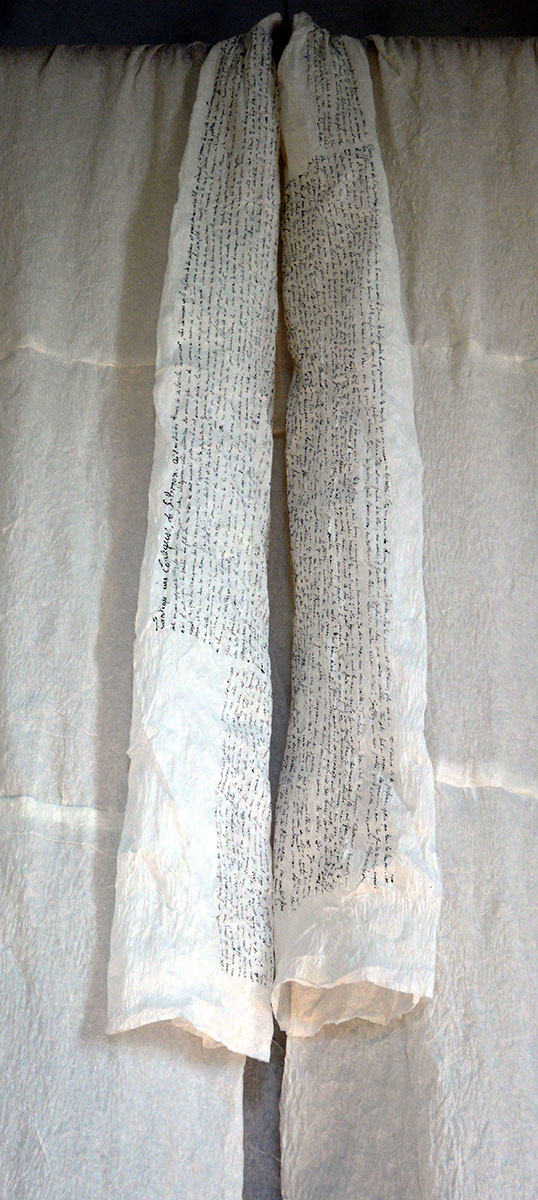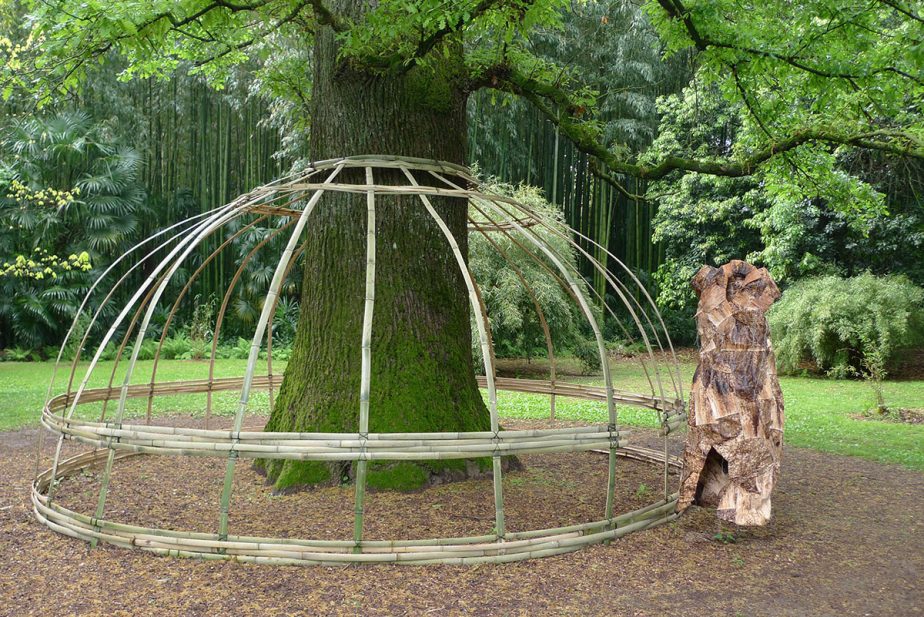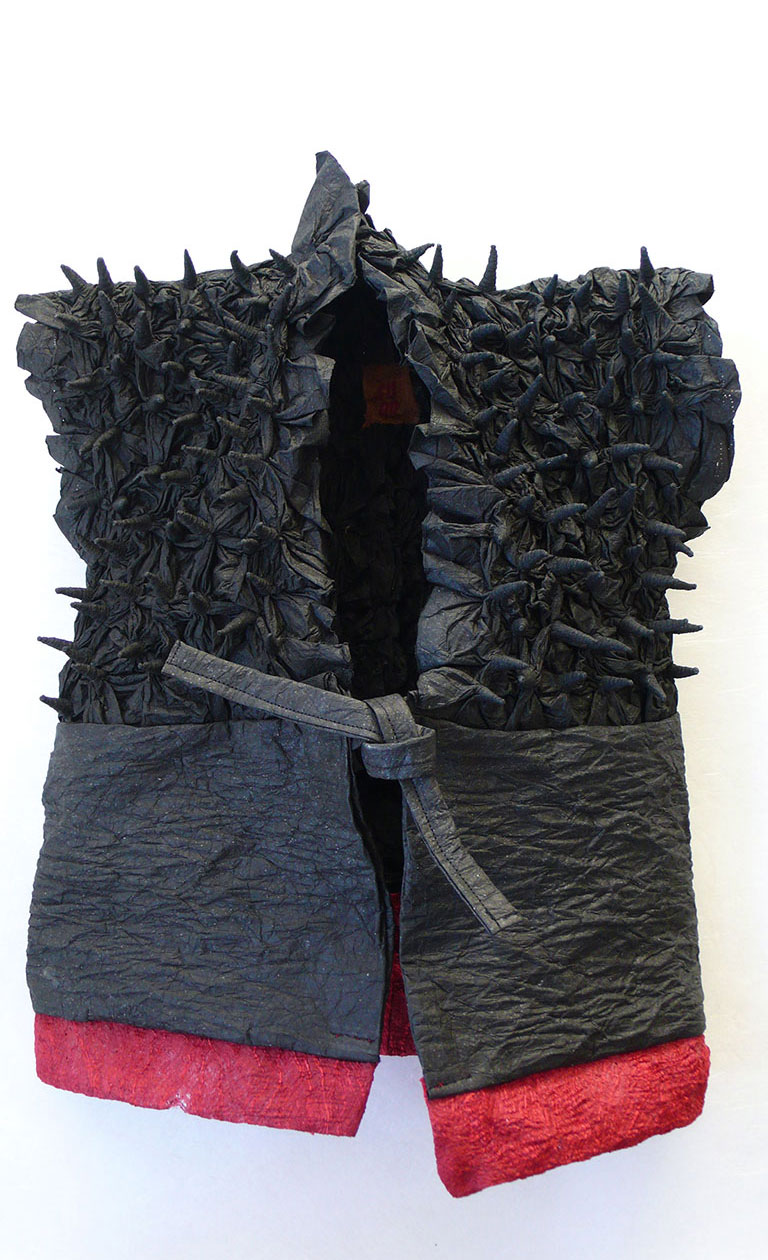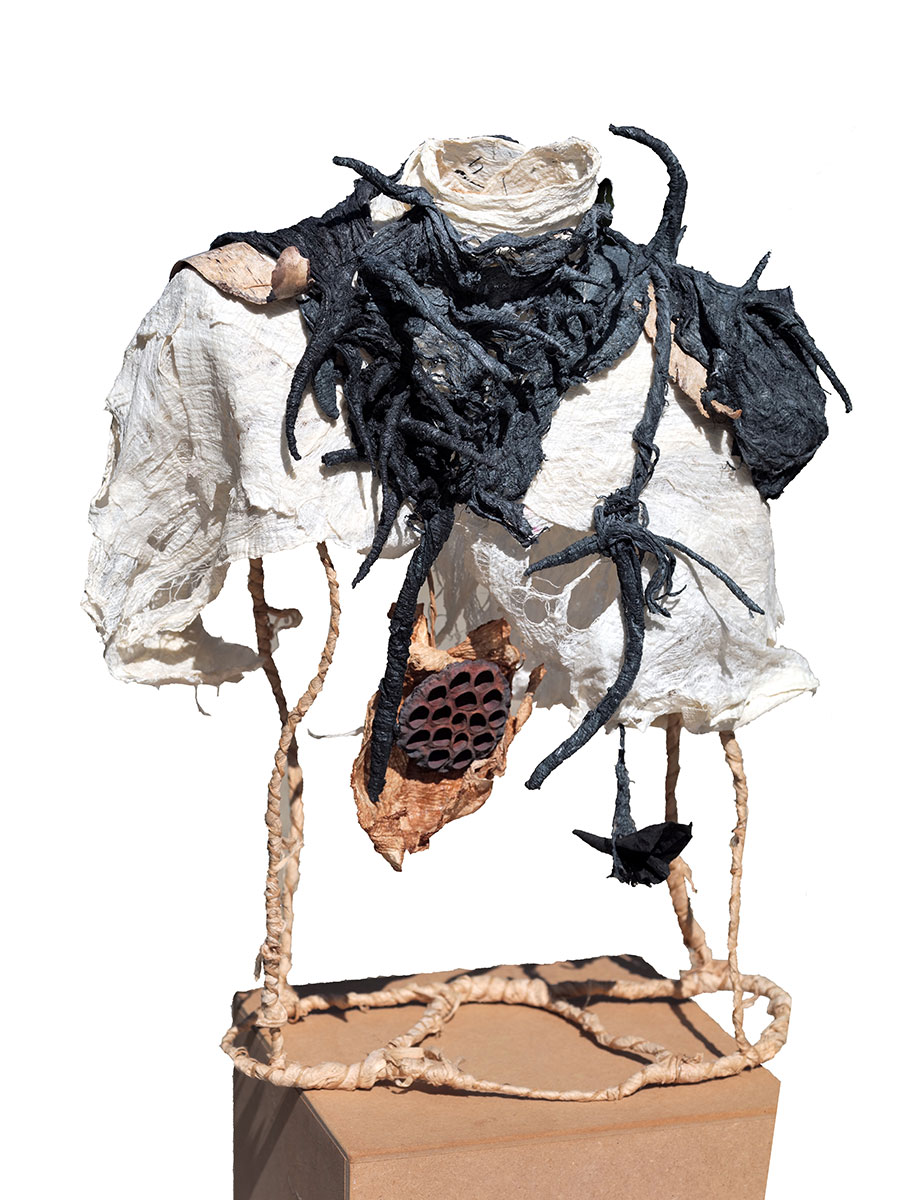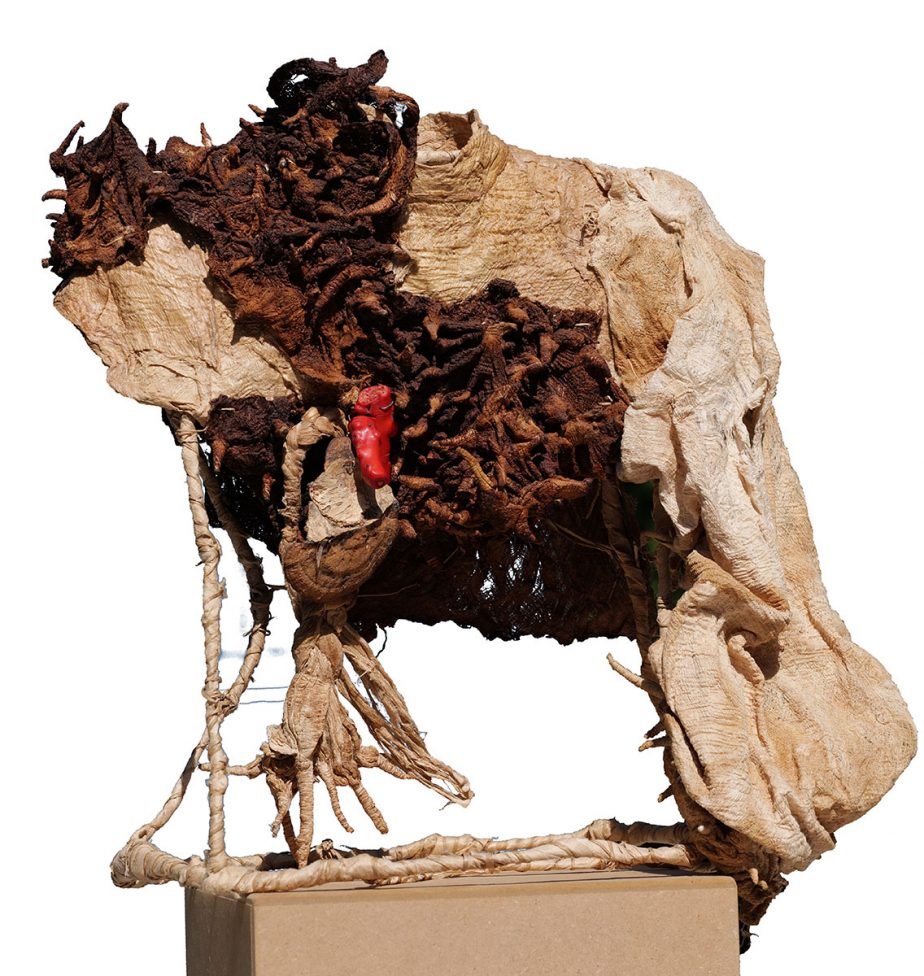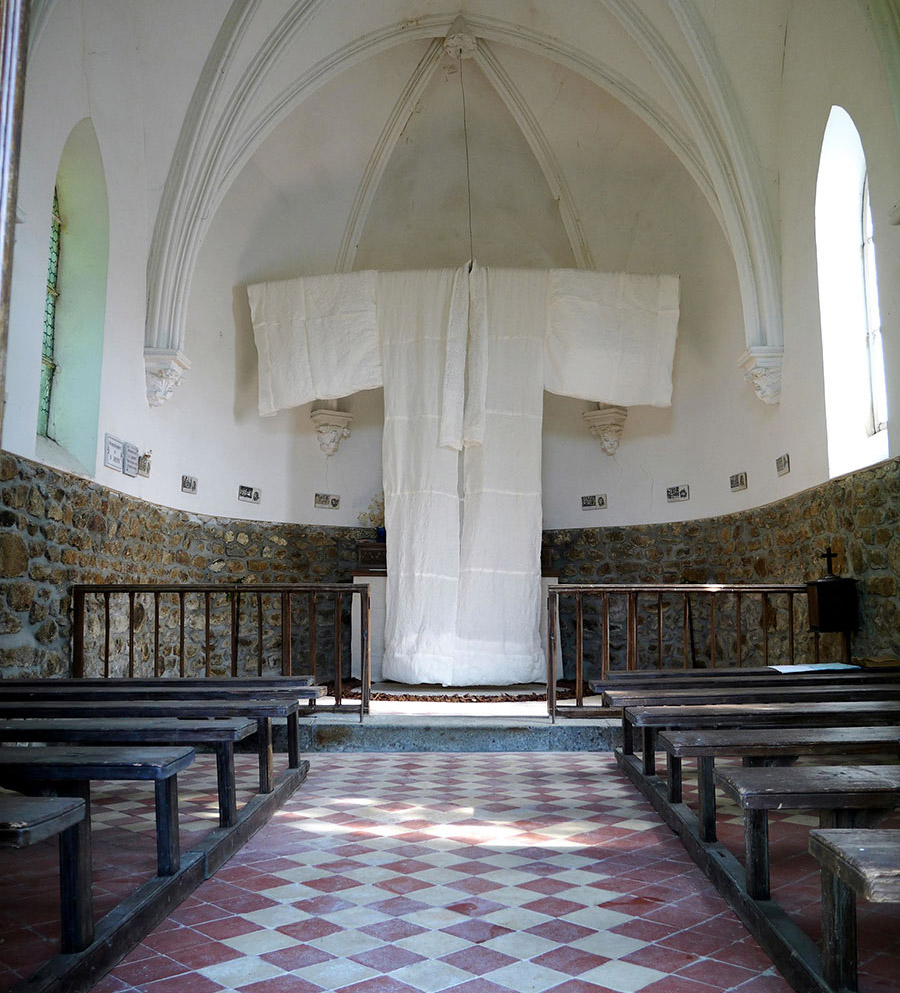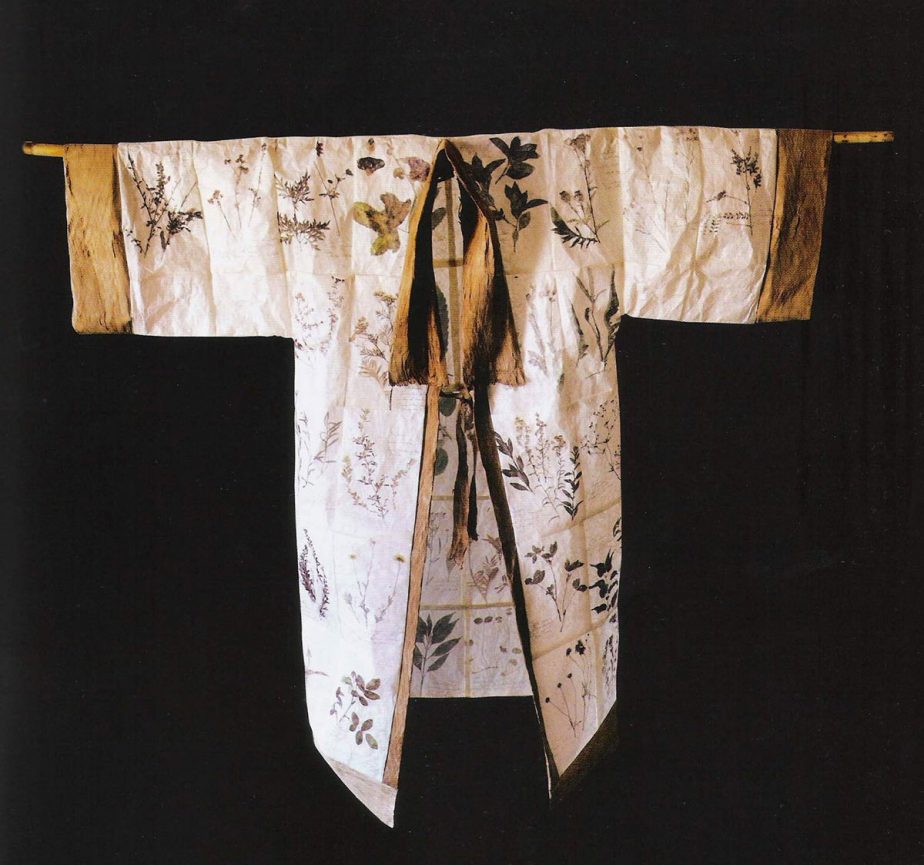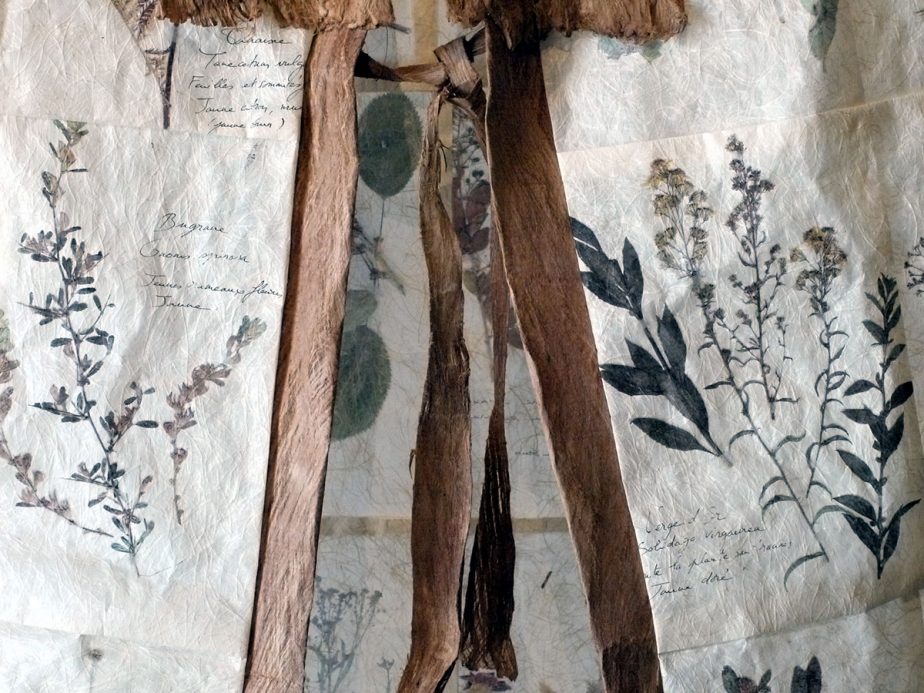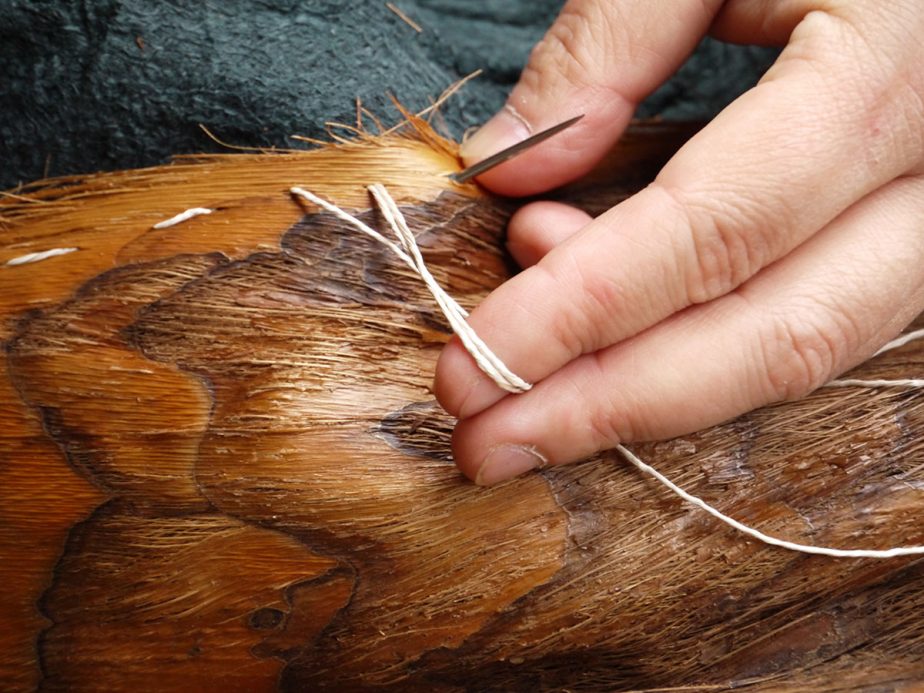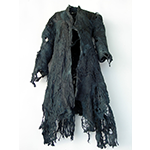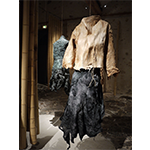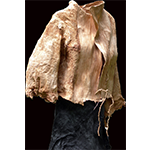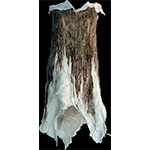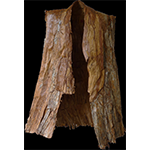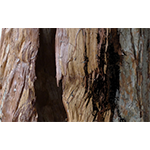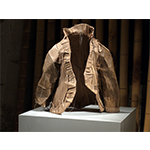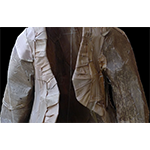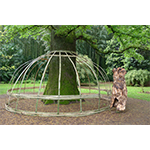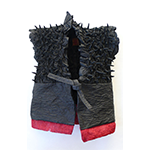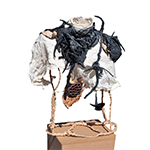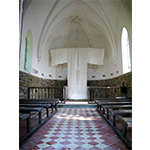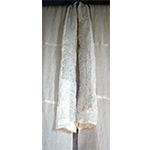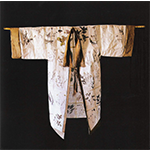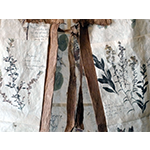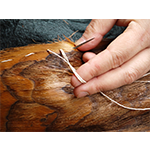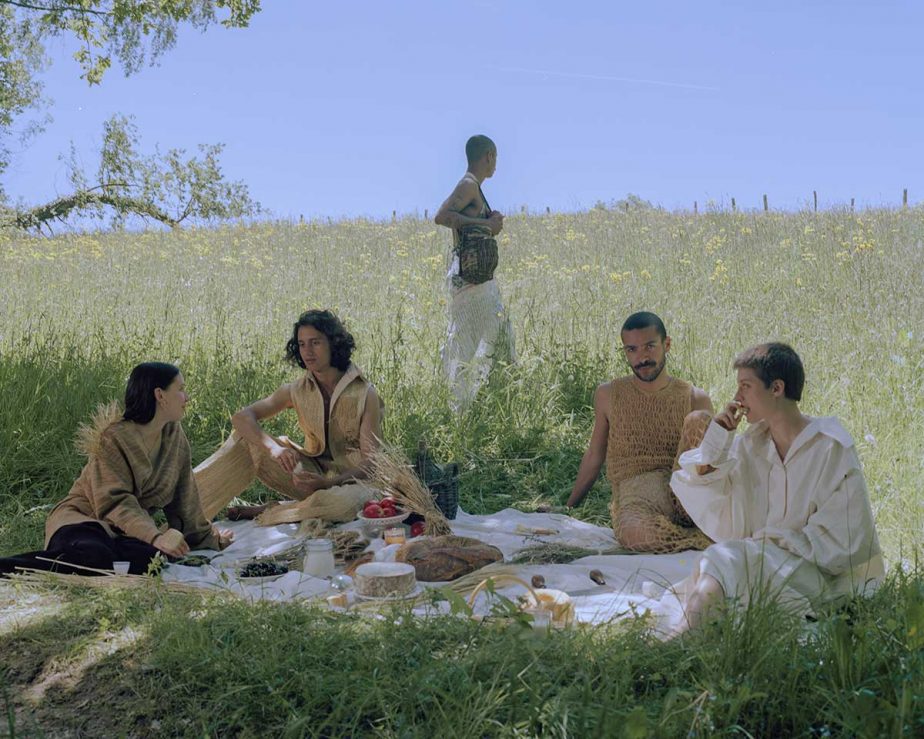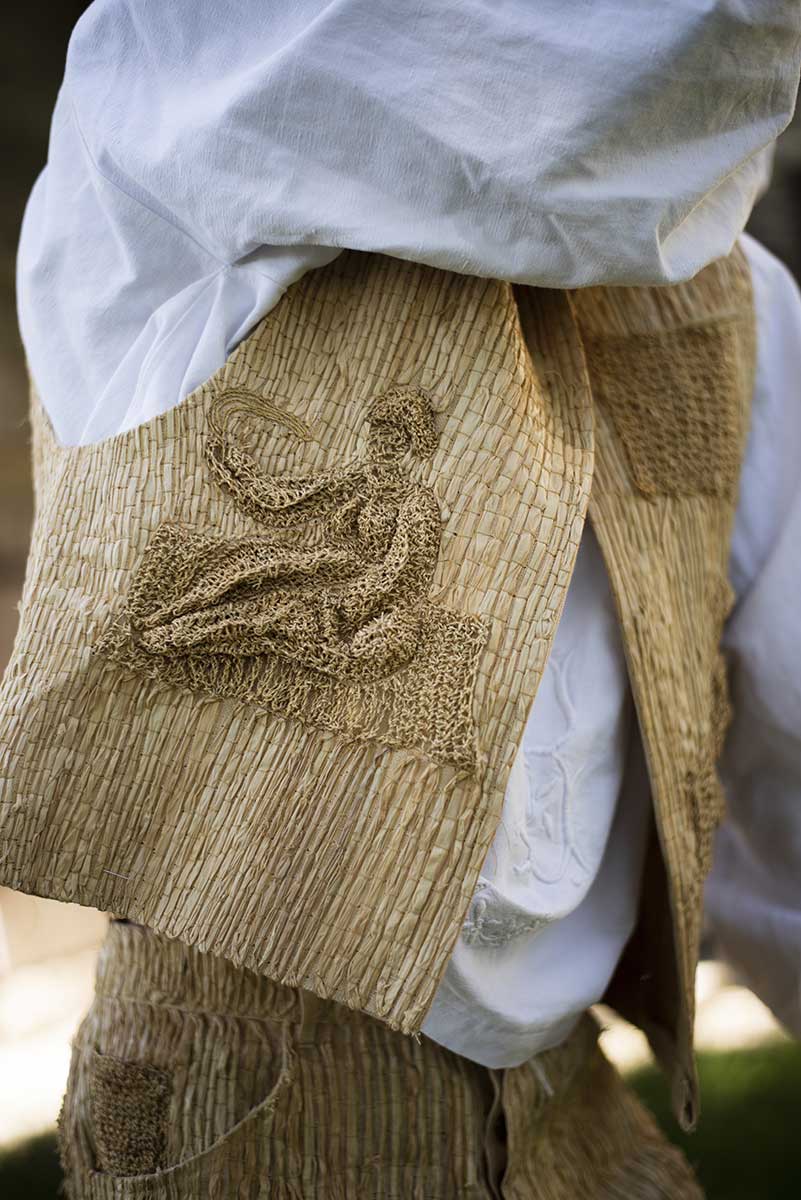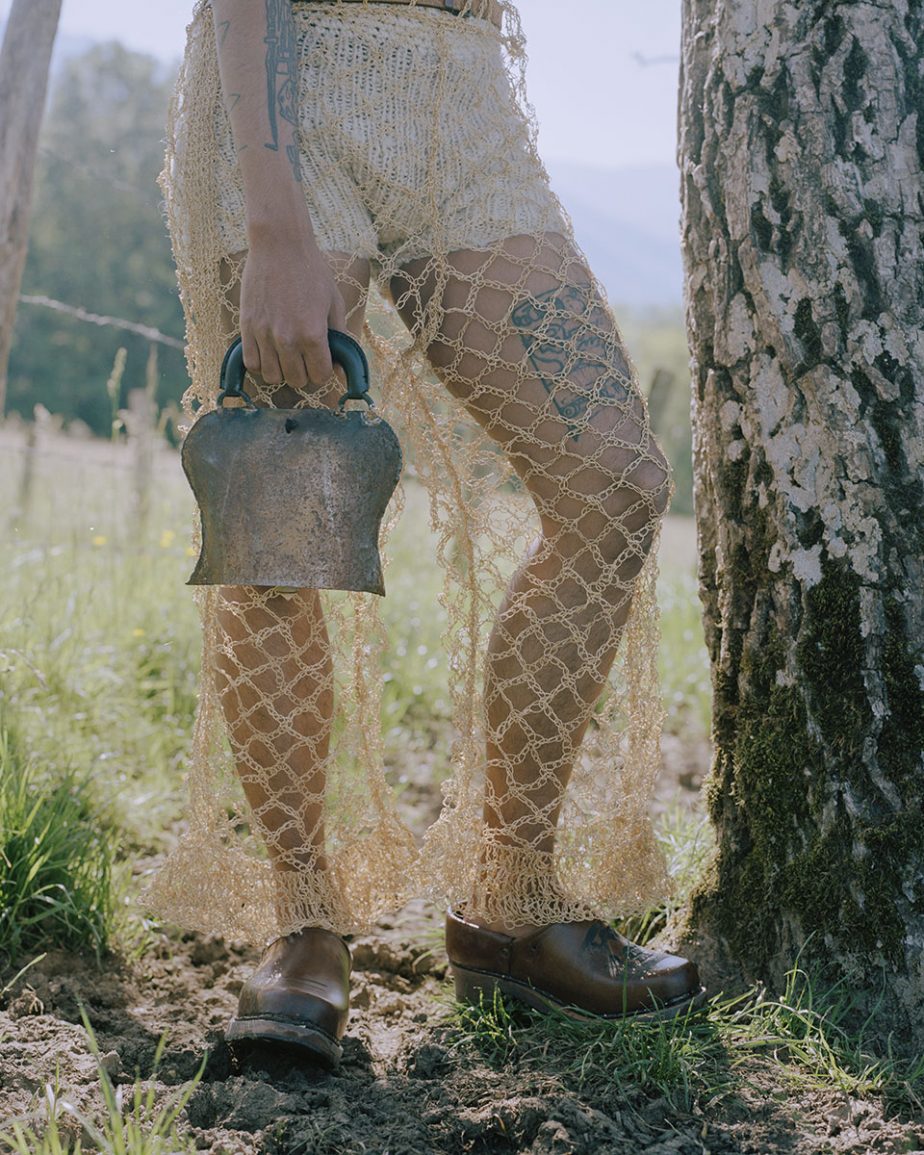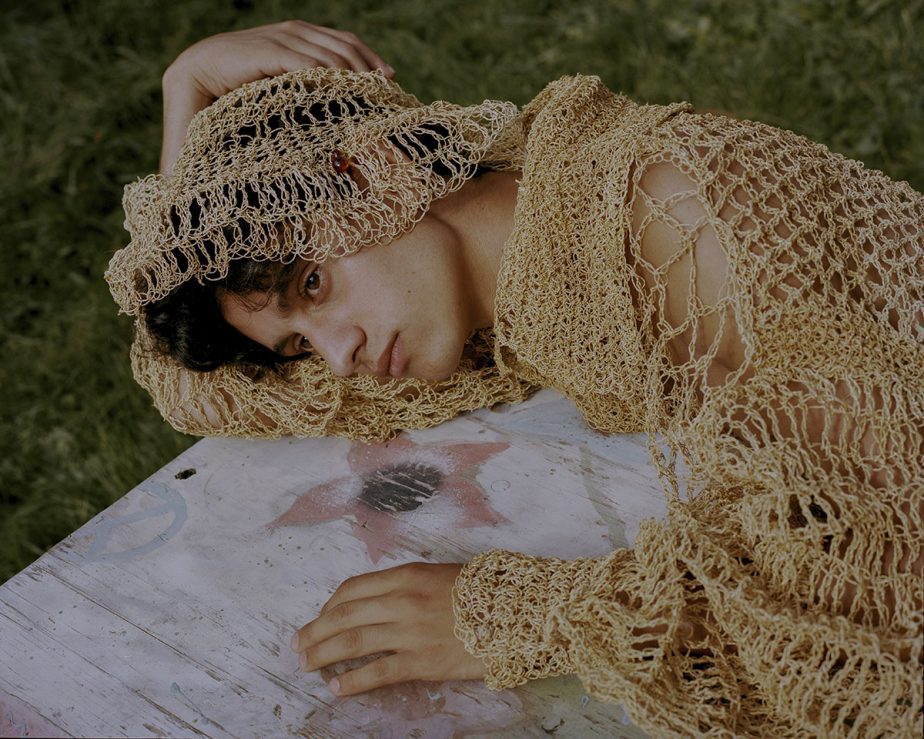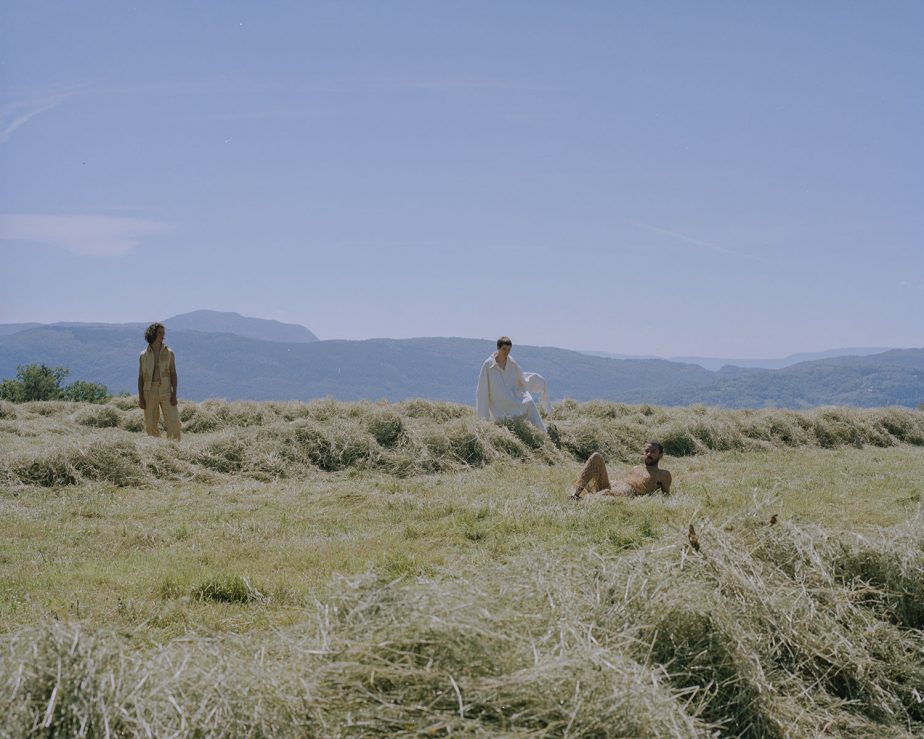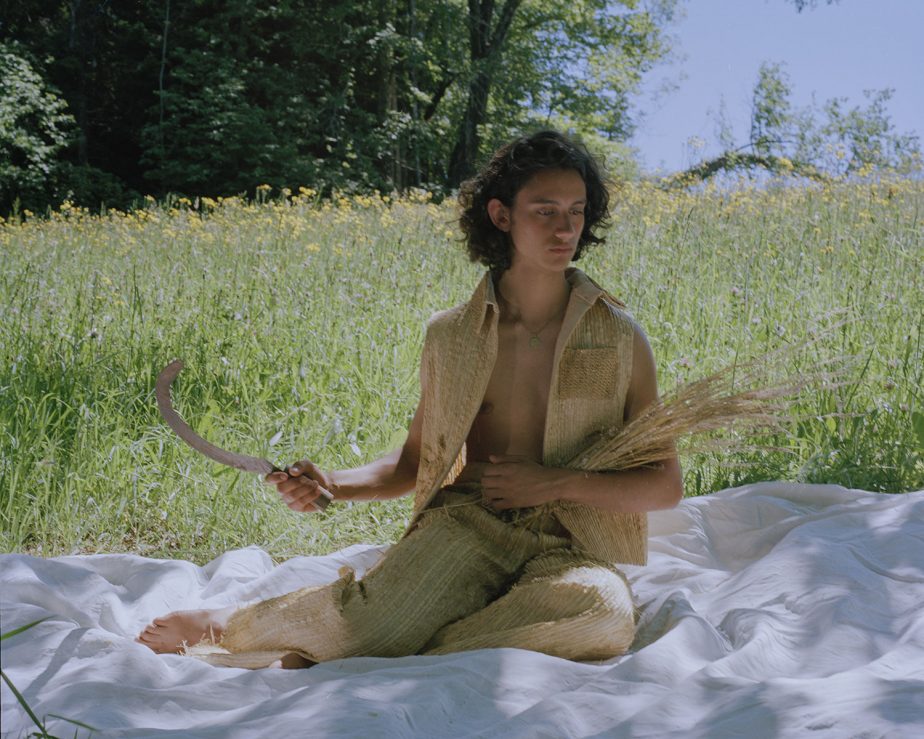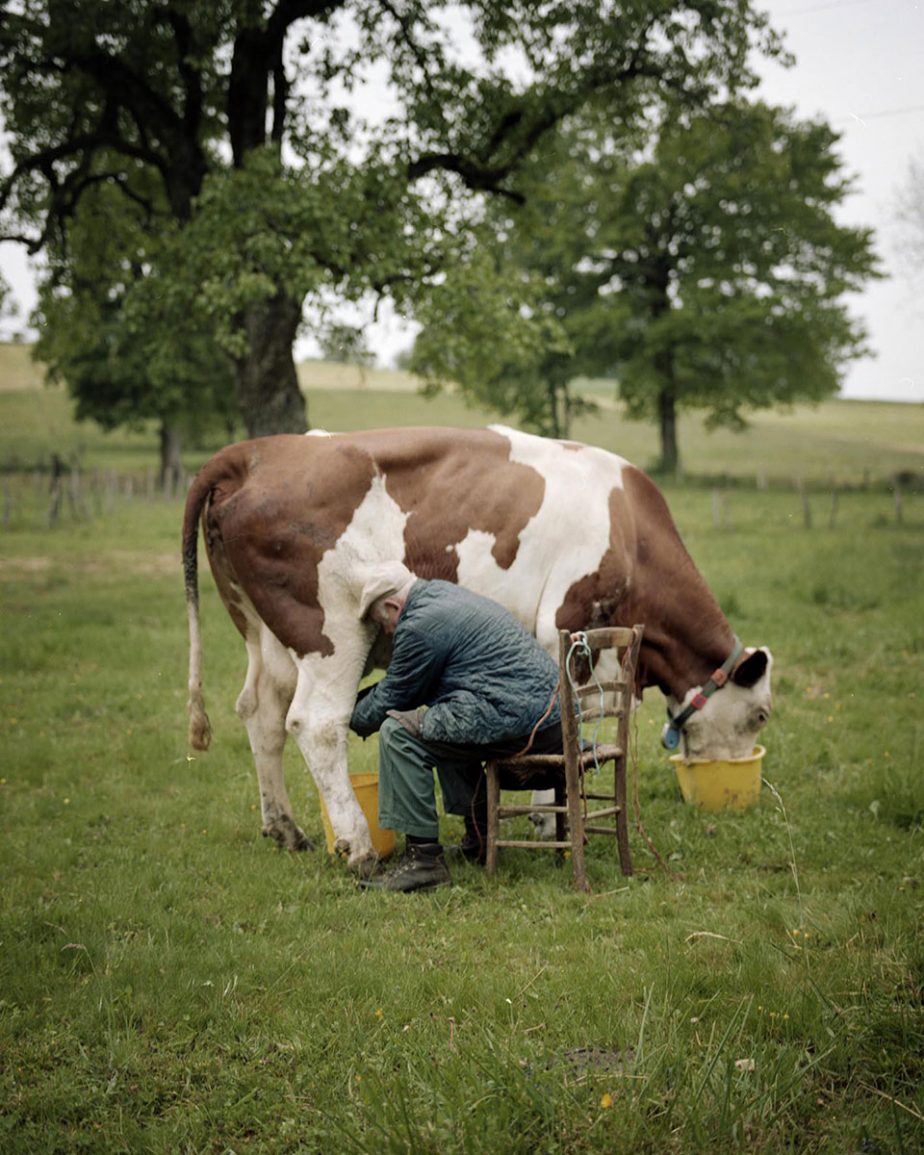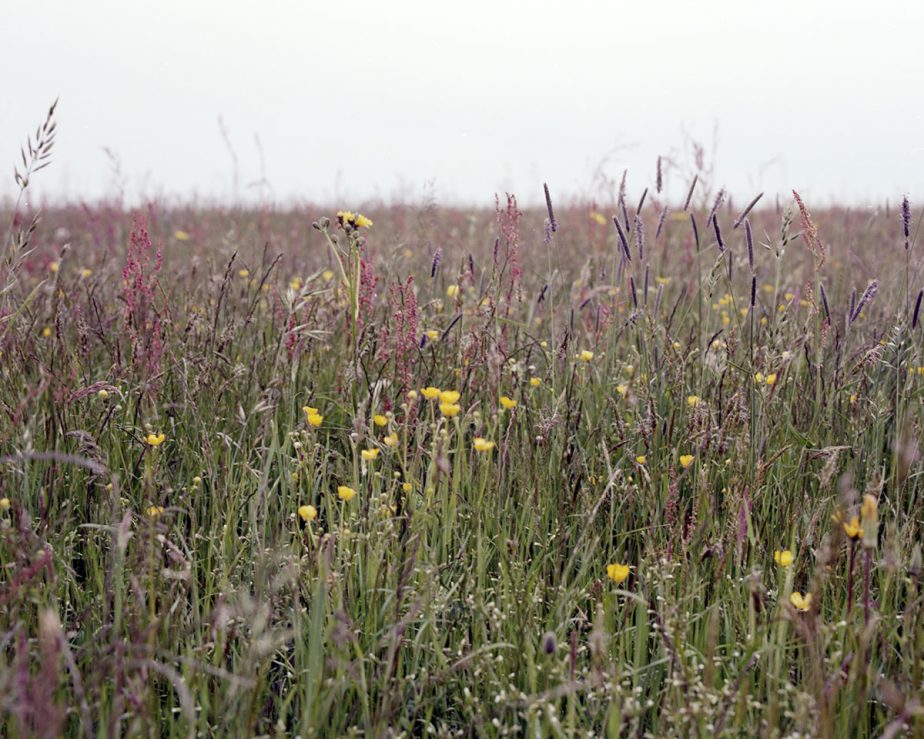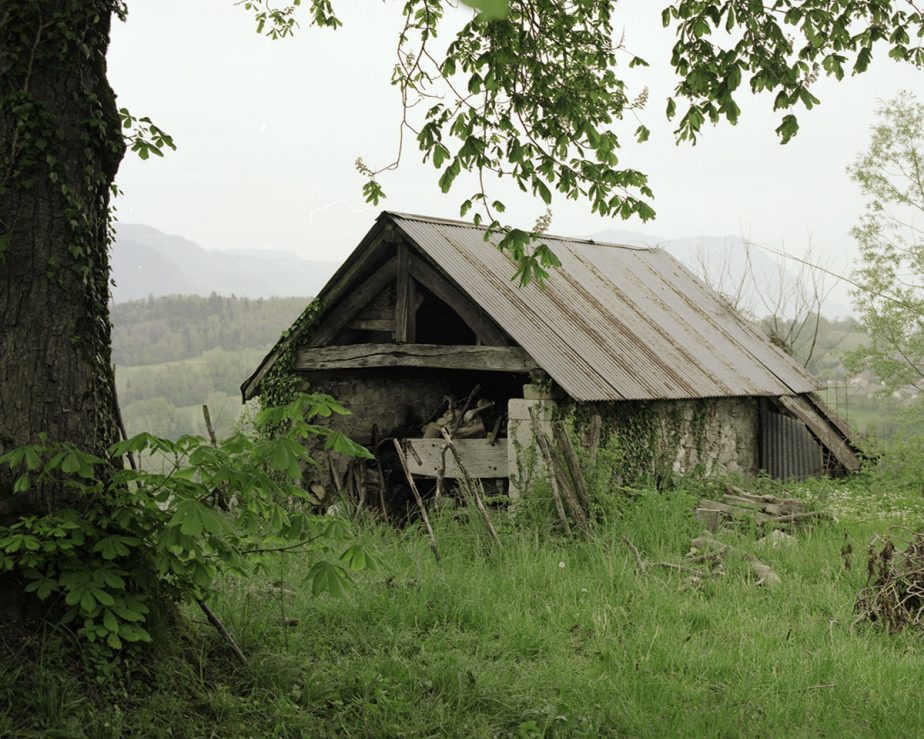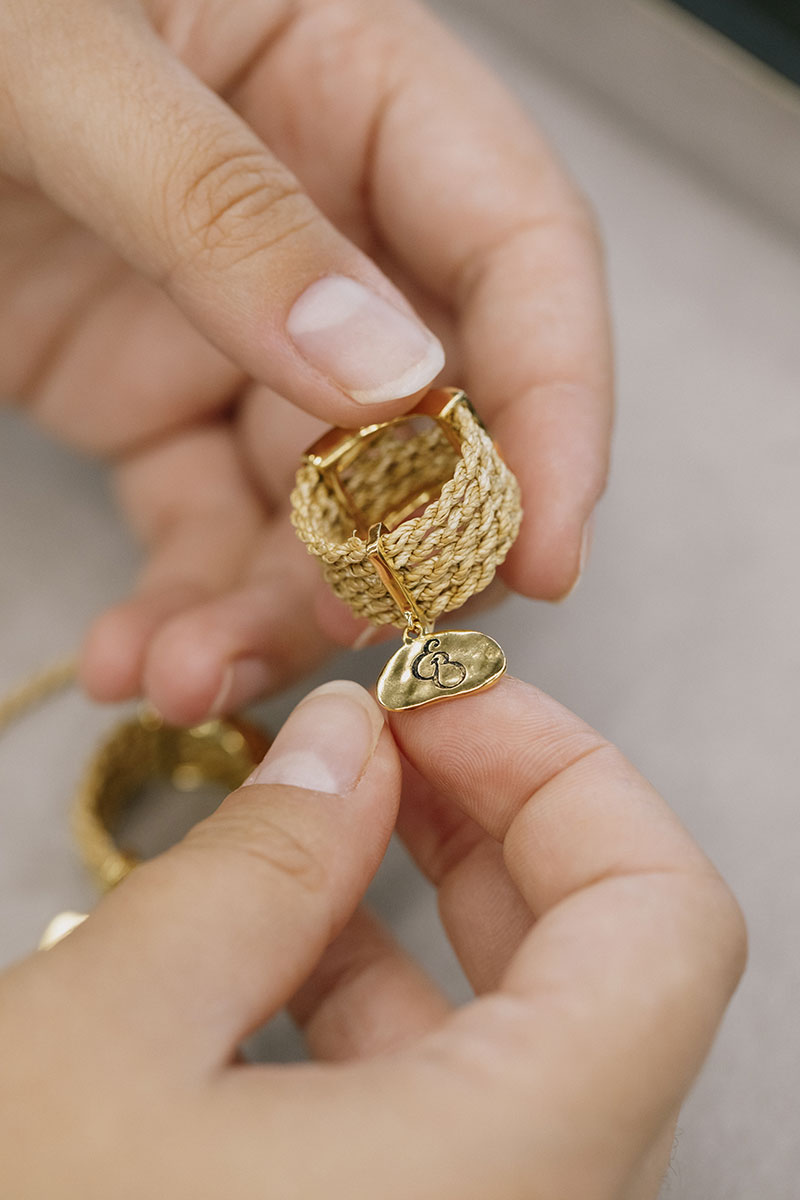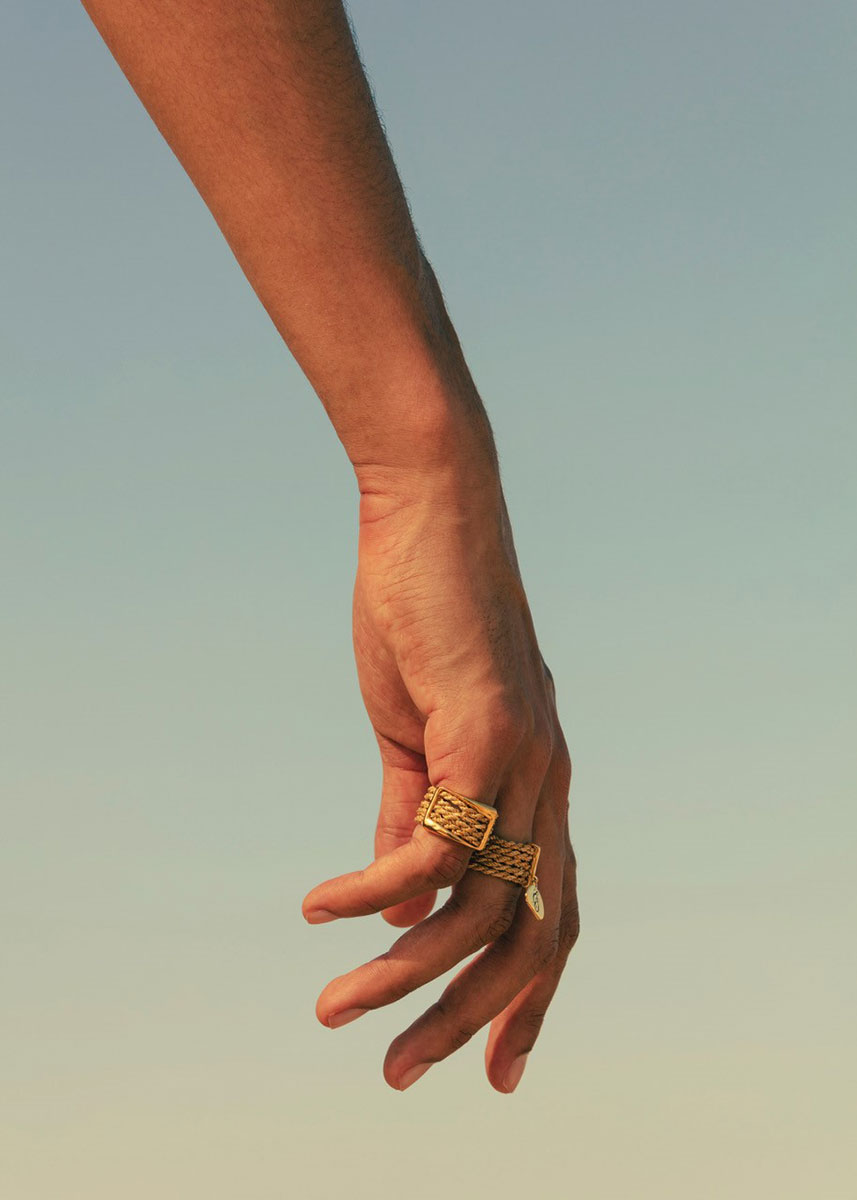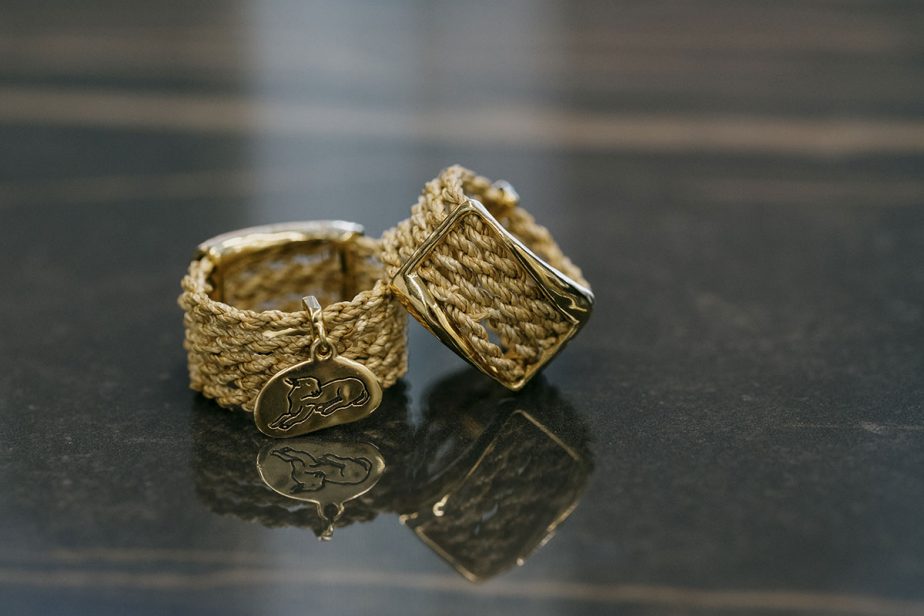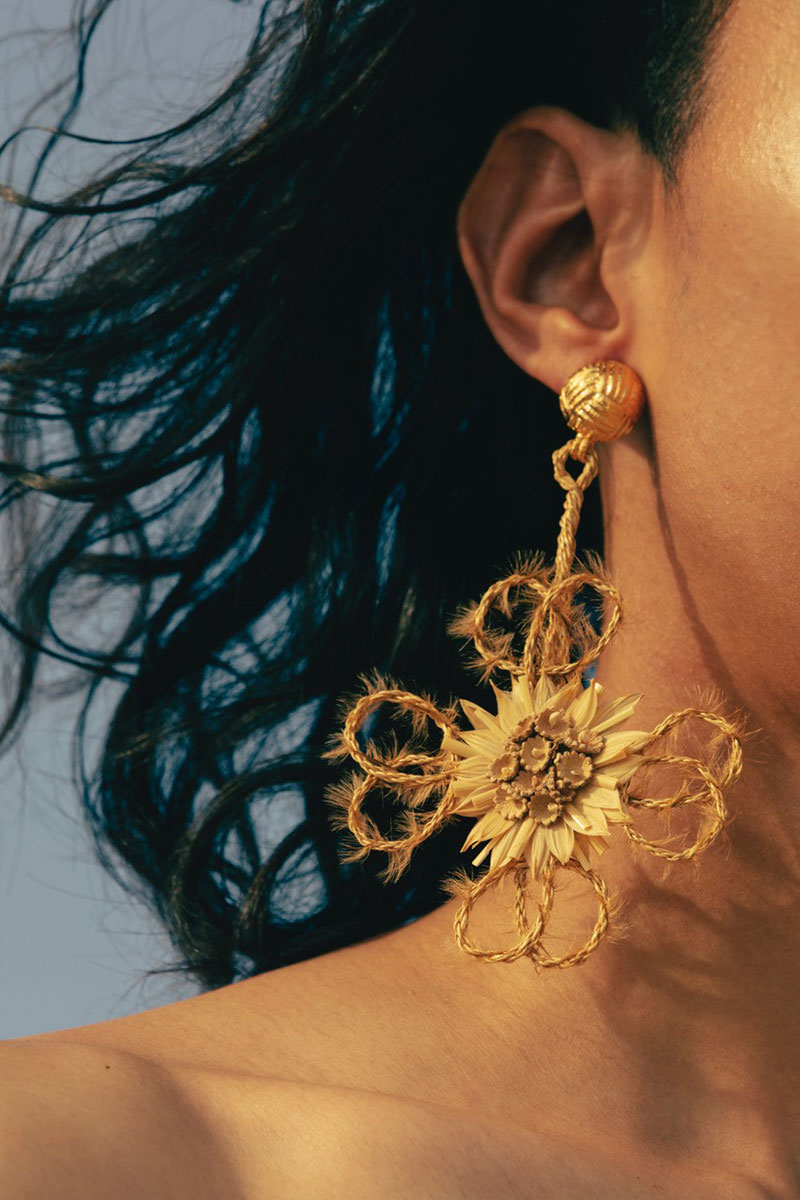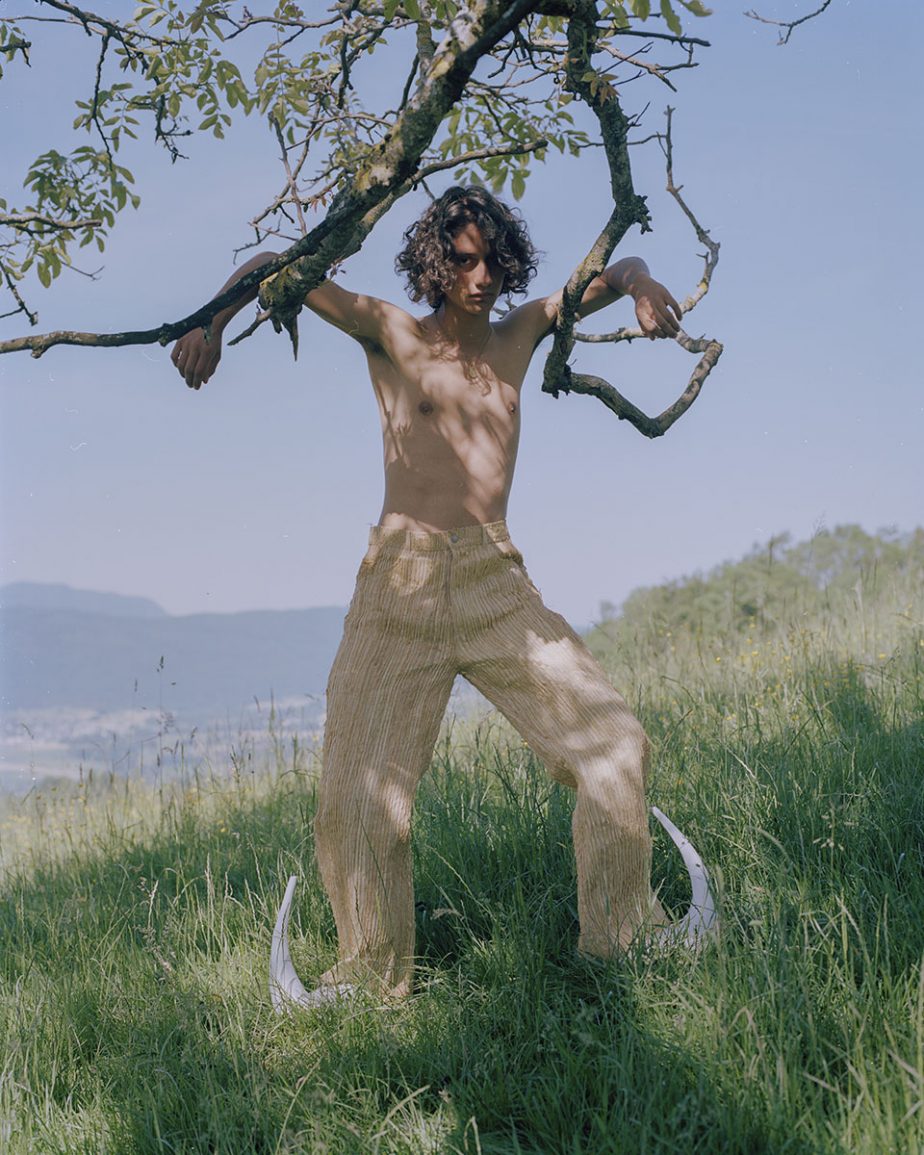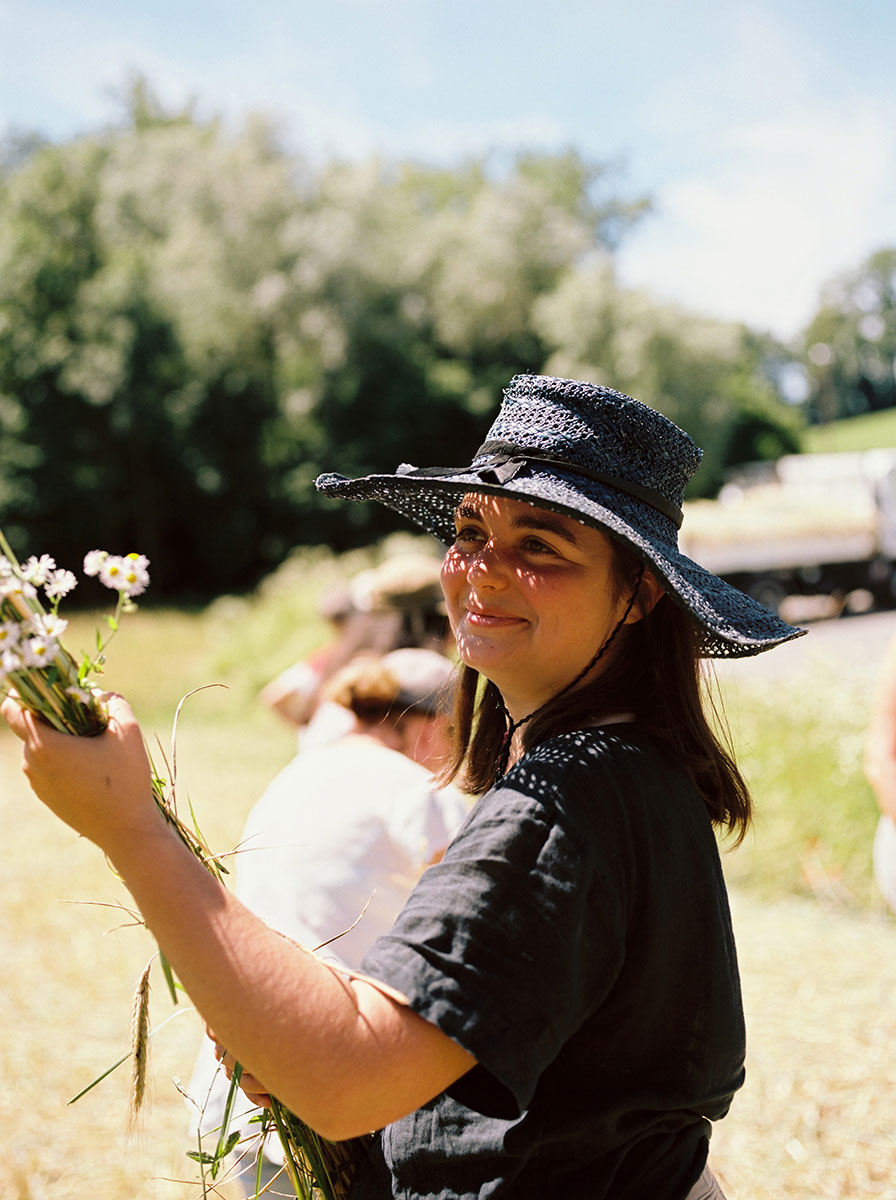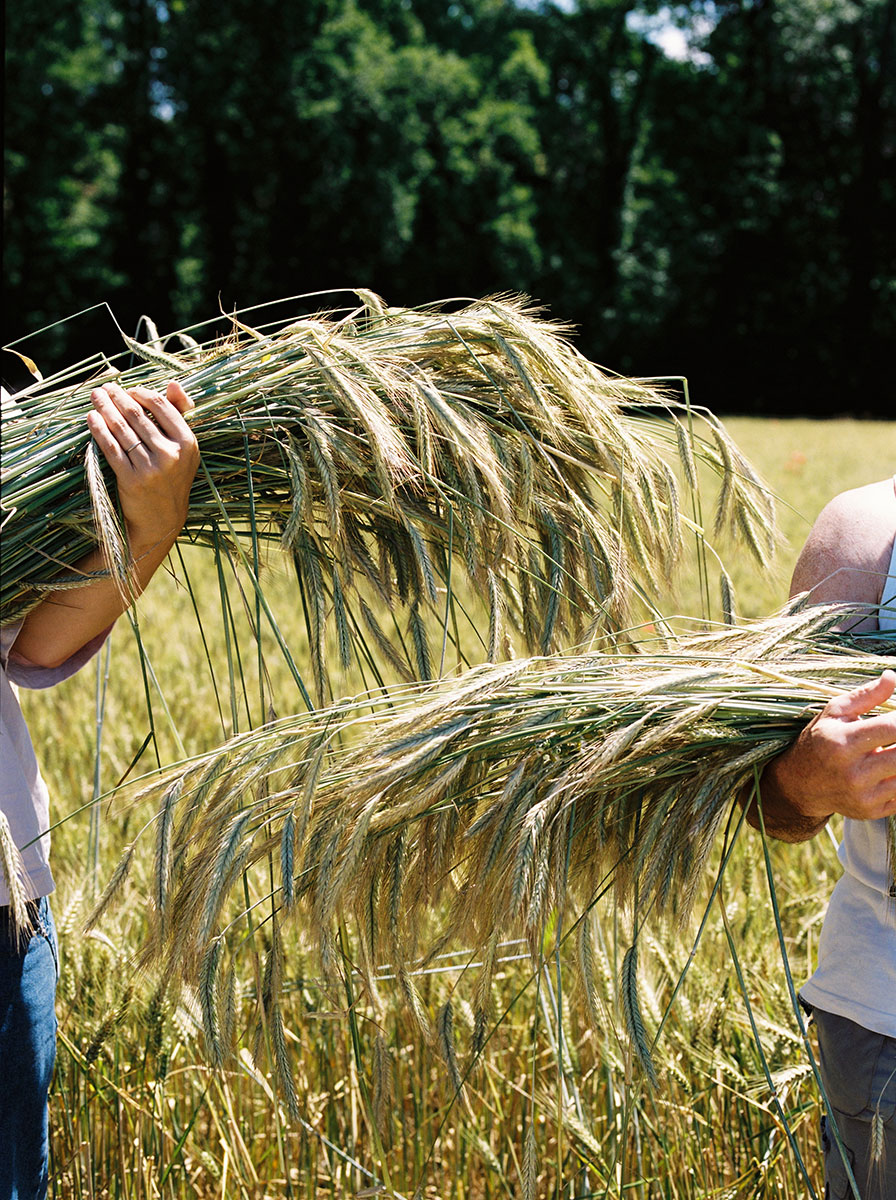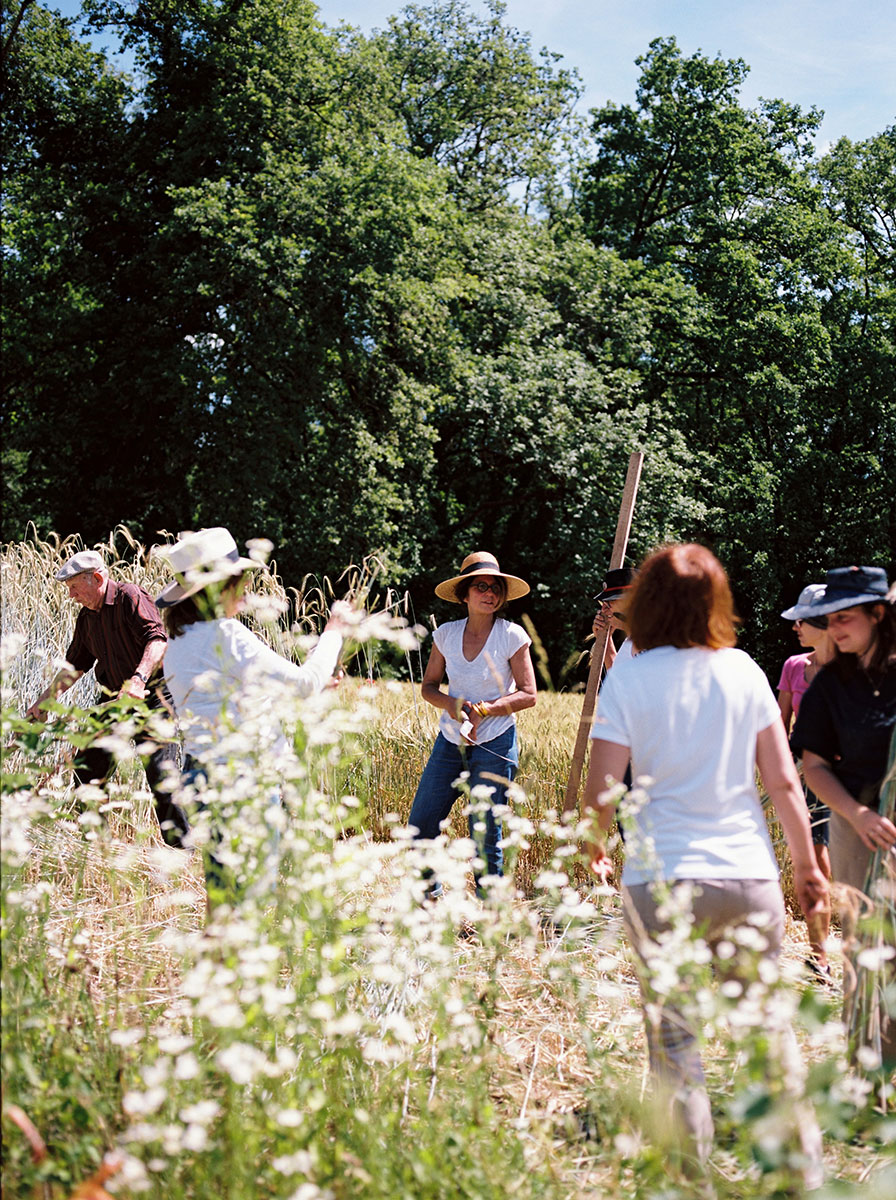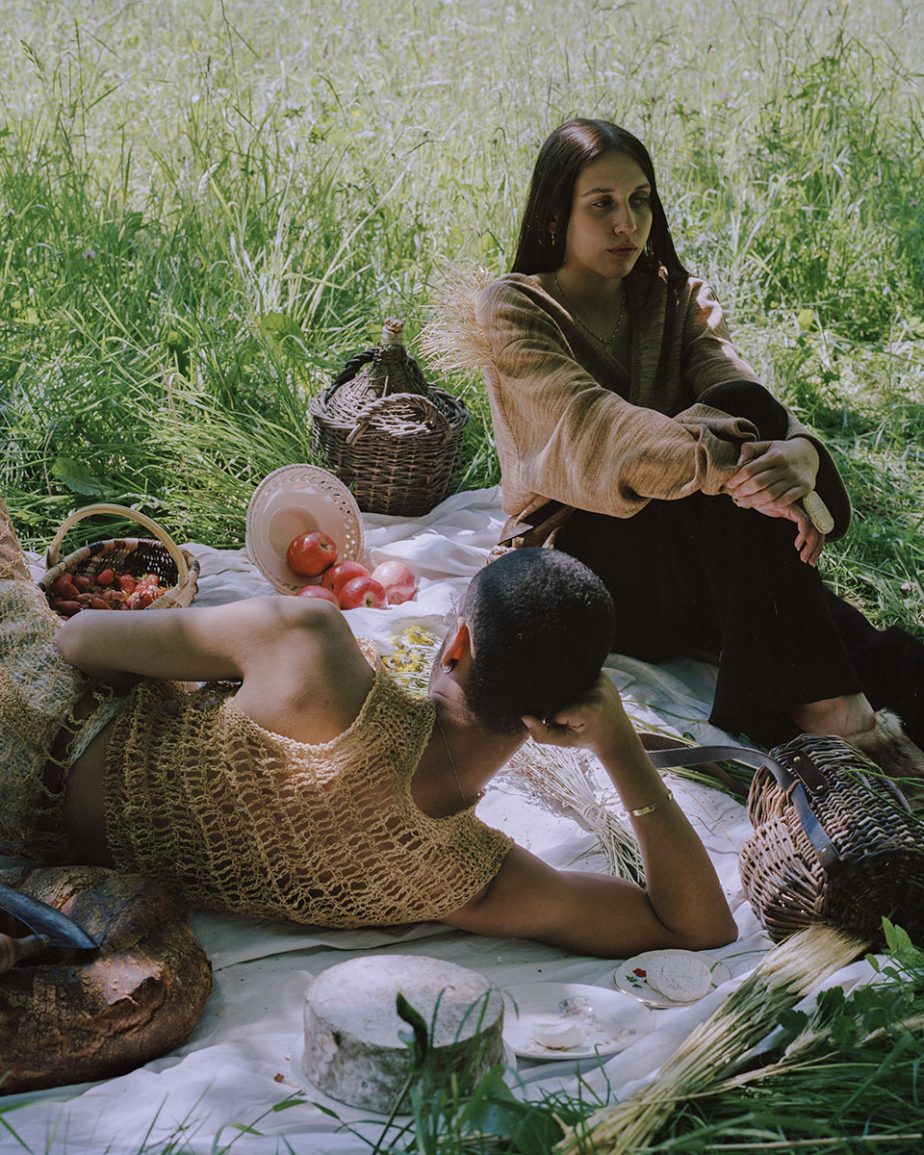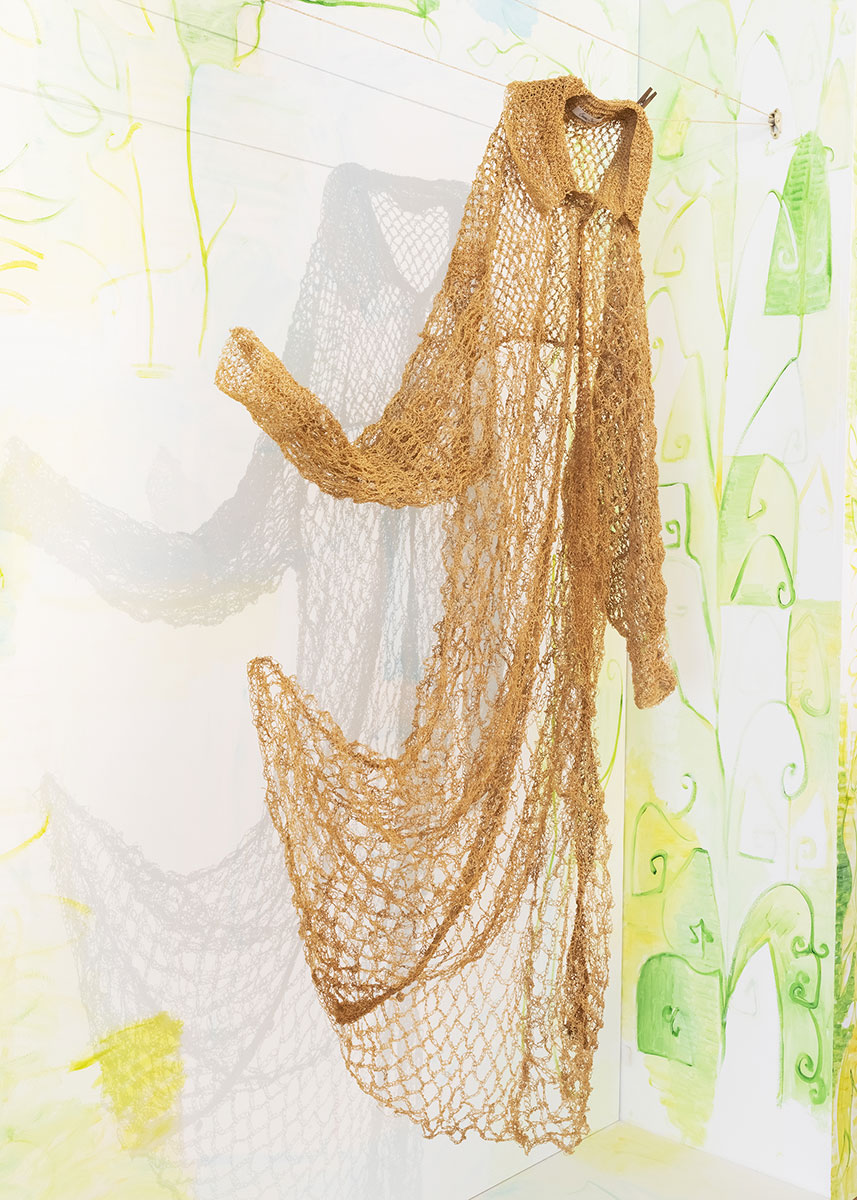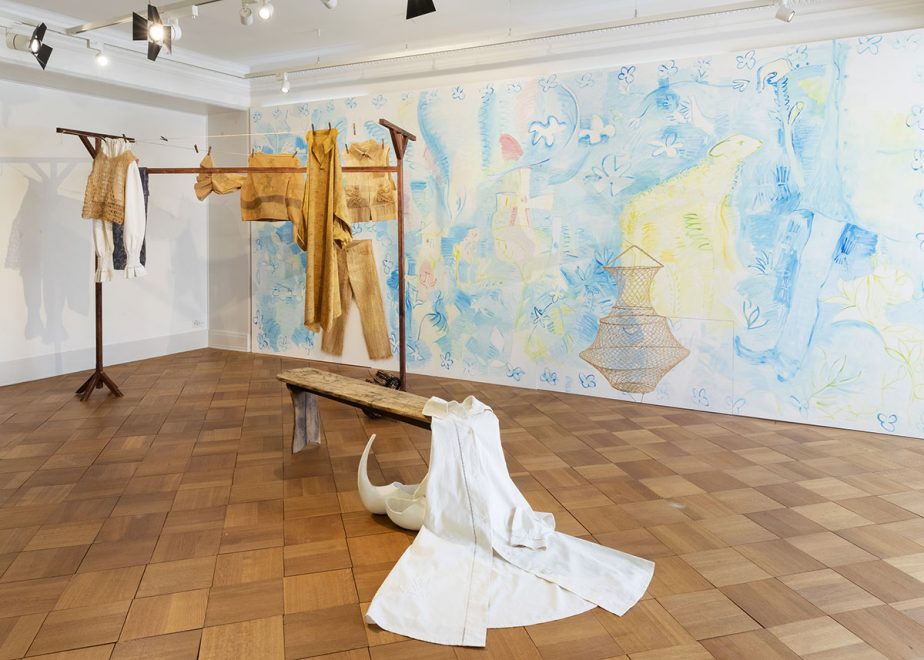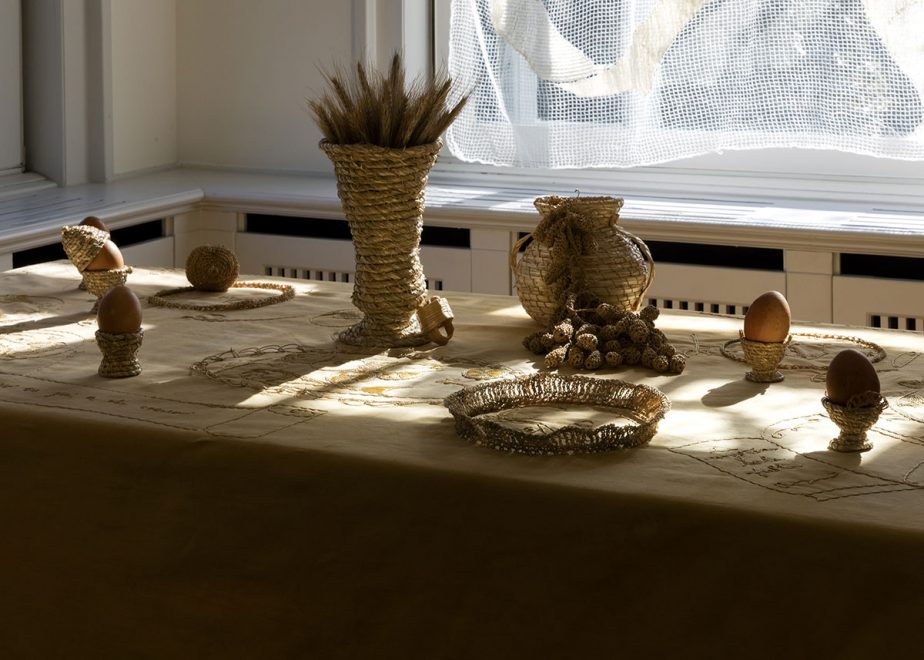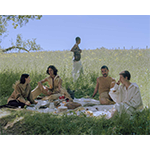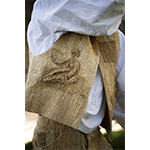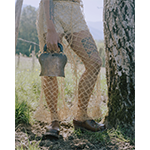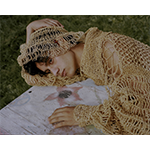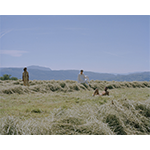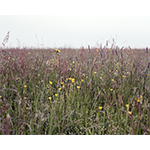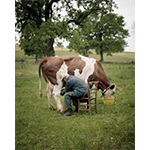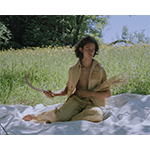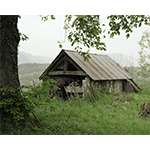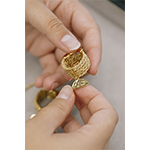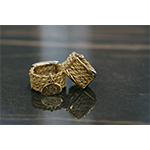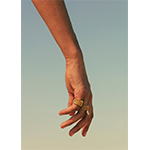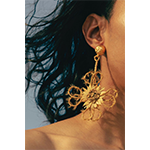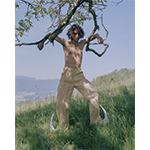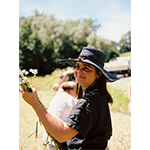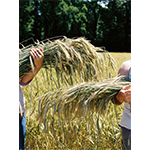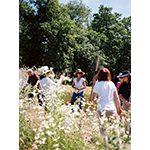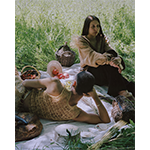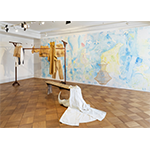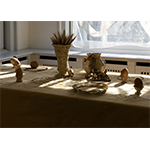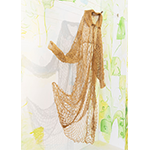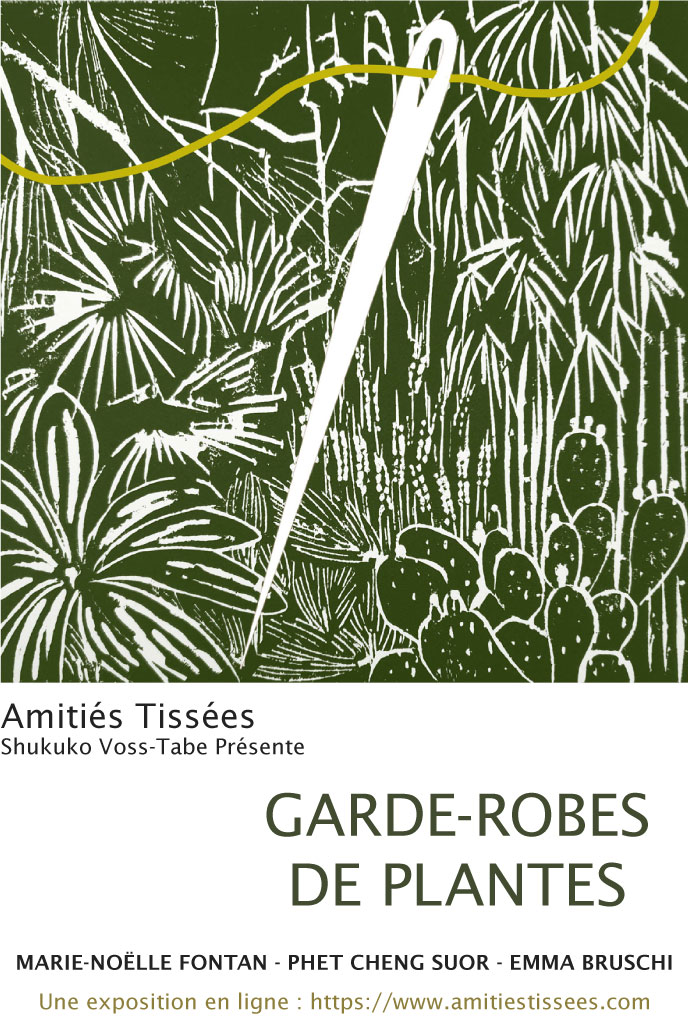
Botanical Wardrobes
Curated by Shukuko Voss-Tabe
All English translaions : Darrell Wilkins
A caricature sketched by Hokusai (1760–1849), the great master of Japanese wood-block prints during the late Edo period, shows a man walking in the rain, dressed in an overcoat made of leaves of the fuki or sweet coltsfoot plant, petasites japonicus. Presumably, he did not have the means to procure a rain-coat and so fashioned his own from the resources at hand. It is an ingenious and poetic invention, partaking of humor and idiosyncratic creativity.
The vegetable kingdom, the supposedly inanimate part of the living world, has its own history—a history incomparably more ancient than that of the human being. Today, it is re-claiming more forcefully than ever its own needs and prerogatives and playing a conscious role in our daily lives. The work presented in the exhibition “Botanical Wardrobes” reveals three artists’ attachment to nature, and in particular to plants. Plants are involved at every stage in the fabrication of their garments.
For Marie-Noëlle Fontan, Phet Cheng Suor, and Emma Bruschi, plants represent a fundamental source of vitality and beauty, and by dint of this deserve to appear in their natural state in art. These three artists thus pursue in their own fields a vein explored in sculpture or land art by contemporary artists such as Giuseppe Penone and Andy Goldworthy.
The artists we present here are not content with using industrially processed materials, even such as are derived from natural fibres like flax, cotton, hemp, or banana and pineapple leaves. They seek out plants in the raw and harvest them directly from nature, in the heart of the forest, on wild bushes, on river banks, or in the fields where farmers grow them.
The textiles of Marie-Noëlle Fontan are woven of fibres taken from lily leaves, the cactus pear, bamboo sheaths, orange peel, or pine needles. Phet Cheng Suor uses the bark of the mulberry, niaouli, or Chinese palm trees to produce “vegetable kimonos.” Emma Bruschi creates clothing and accessories out of straw. All three do without the industrial processing typically employed in the manufacture of textiles.
In the hands of each of these three artists, the plants which form the basis of their work retain their natural appearance and vitality, even as they are transformed in extraordinary fashion into works of art—an art of textiles and clothing which is at once archaic and utterly contemporary. One can easily imagine the delight which pre-historic women might have felt in adorning themselves with these beautiful fabrics, made of plants gathered from their own surroundings; just as we are delighted by these artists’ subtle and numinous creations.
I invite you to explore the following pages of this exhibition; to take a stroll through this garden of objects made by the craft of human minds and hands—through this intimate museum of artworks taken by the artists, with a graceful sleight of hand, from the very bosom of nature.
Association Amitiés Tissées
Shukuko Voss-Tabe
www.amitiestissees.com
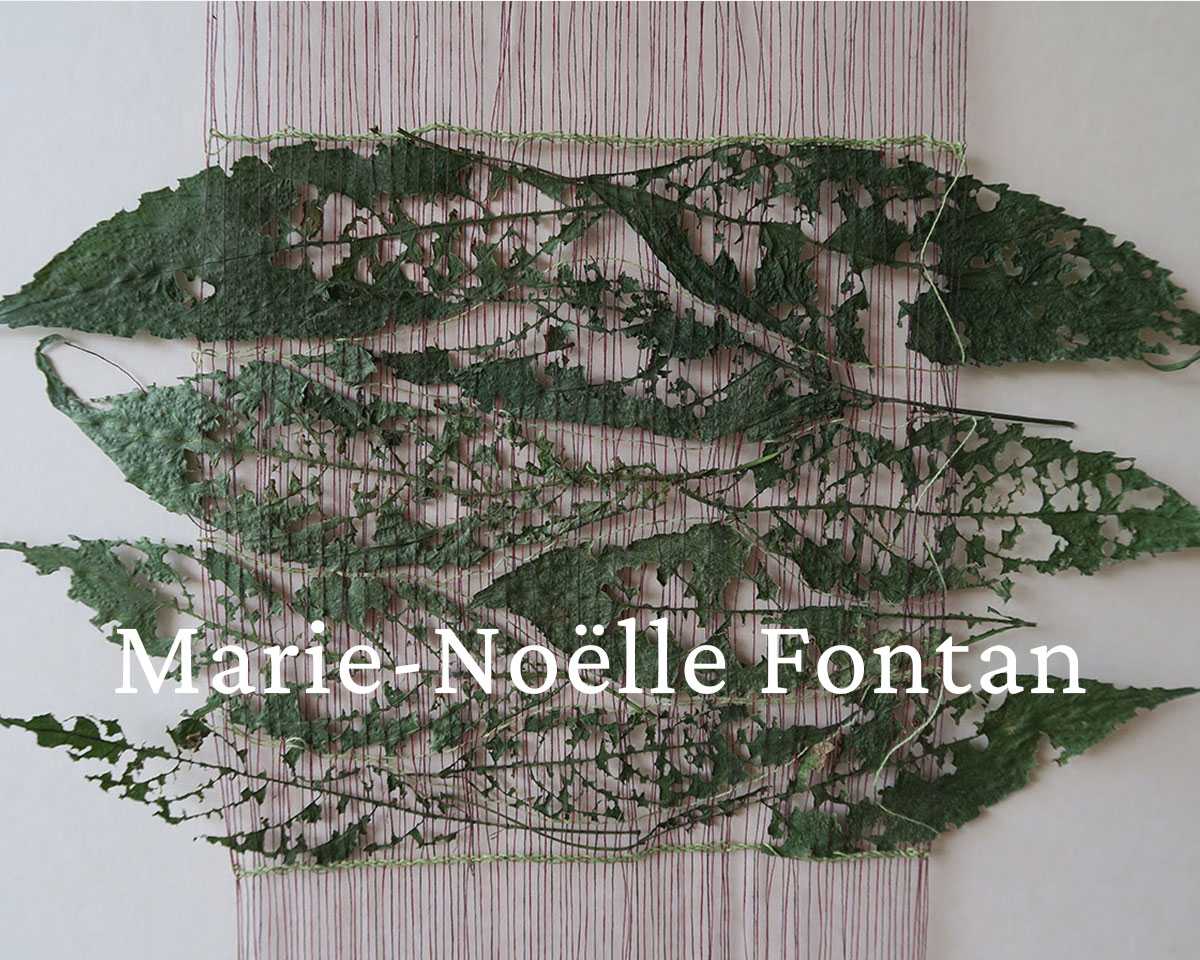
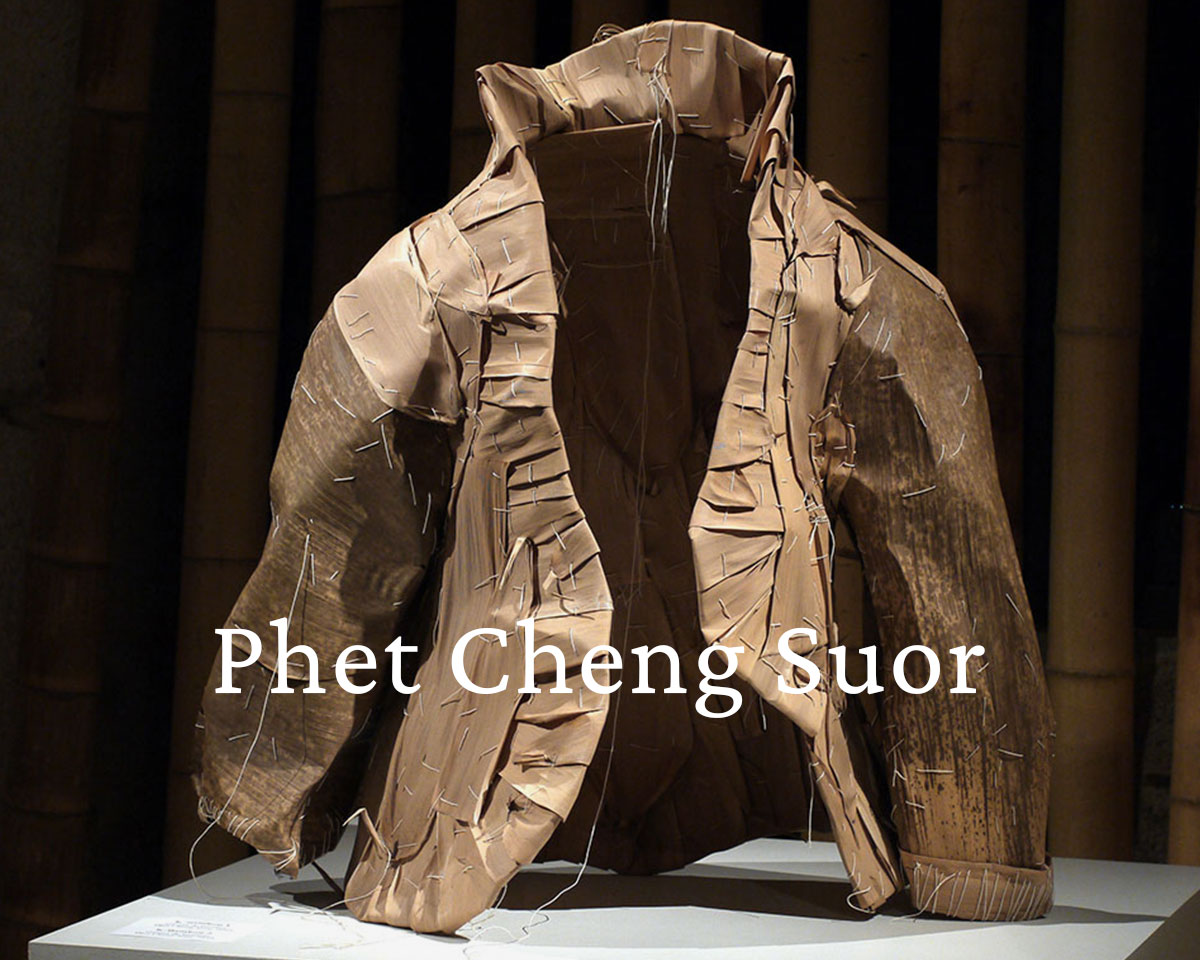
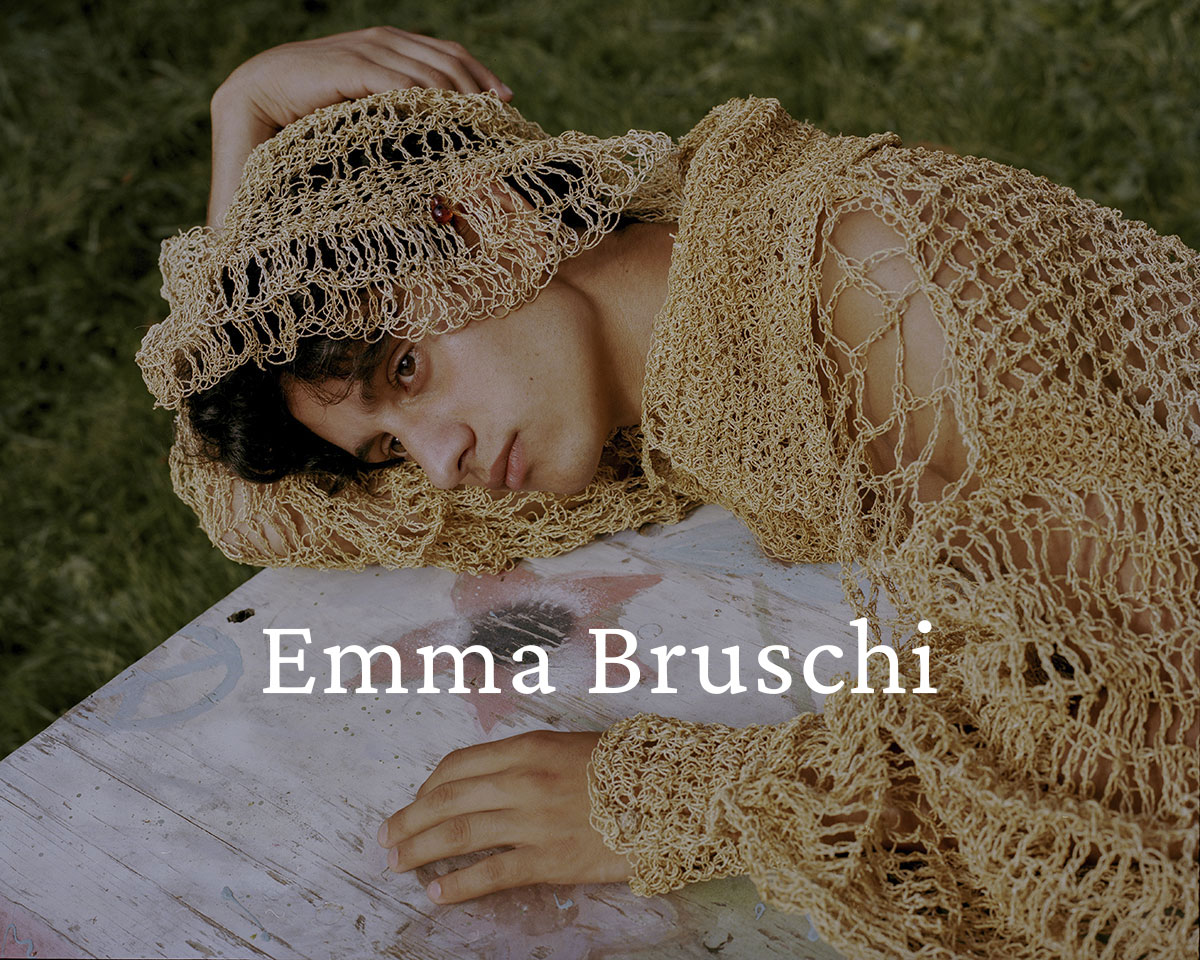
Marie-Noëlle Fontan
Manifestly inspired by the life of plants, Marie-Noëlle Fontan brings to her work an eye deliberately informed by botany. The artist is naturally inclined to reveal an immanent harmony among her materials, colors, and forms. Her work draws boundless inspiration from the generosity of the vegetable kingdom, whether of plants, herbs, or trees. Leaves, twigs, bark, seeds, flowers, and fruits—all contribute their vibrant coloring and textures to a creativity and handicraft remarkable for its delicacy. It is as if the artist is weaving nature itself, in the form of an inspired bouquet of wildflowers, into the weft of a linen or cotton fabric. In her work, even the most anodine leaf takes on the allure of a graphic sign. Here, art talks about nature, and nature about art.
(This paragraph is taken from a text by Ambroise Monod, Paris 2008.)
Site : www.marie-noelle-fontan.com
Instagram : #fontanmarienoell
Title | Year | Materials |
Lunaire | 2005 | Beans & Branches of Lunaria and cotton yarn |
Aspidosperma | 2012 | Bark of banana tree, beans of Apiosperma and cotton yarn |
Leaves , collected in El Pilar | 2016 | Leaves (non identified) and cotton yarn |
The two fishes | 2020 | Leaves of Monstera Obliqua and linen yarn |
Monstera | 2016 | Leaves of Monstera Obliqua and linen yarn |
Pithecoctenium | 2011 | Beans of Leaves of Pithecoctenium Crucigerum and cotton yarn |
Title | Year | Materials |
Ebb tide | 2013 | Different plants, gatherd on the beach and cotton yarn |
Licuala | 2009 | Leaves of Licuala palm tree and cotton yarn |
Samares of maple | 2012 | Leaves of maple and linen yarn |
Lapsanne commune | 2005 | Lapsanne commune and cotton yarn |
Ebb tide | 2013 | Different plants, gatherd on the beach and cotton yarn |
Aristoloche | 2020 | Different plants include aristoloche and cotton yarn |
Phet Cheng Suor
After painting and engraving, there were the plants, collected, dreamed, and transformed into paper, into “vegetable window-panes” and “artist books.”
I pursued a sculptural and poetic dialogue with the vegetable, creating sculptures of clothing out of the bark of mulberry or niaouli trees, palm-leaf fibres, and bamboo sheaths; like a second, vegetable skin of which the whole parts dress, and the voids inhabit, the ethereal and disincarnate existence of a transitory being.
To create my ‟vegetable wardrobe,” I worked with the form and symbolism of the garment as a footprint, a trace, a poetic envelope for bodies and beings. The garment is the ‟concrete” and aesthetic incarnation of the being, while also acting as a second, intimate skin, which one chooses to wear on one’s body in order to protect oneself, to show oneself, to exist.
I invite you to take a walk in my ‟garden of souls,” of ‟transitory beings,” among the bark of mulberry or niaouli trees, palm-leaf fibres, and bamboo sheaths.
( Text : Phet Cheng Suor )
Site : www.phetchengsuor.com
Title | Year | Materials / Dimension (cm) |
Dress in passing 1 | 2008 | Balk of mulberry tree 70 x 137 x 34 cm |
Dress in passing 4 | 2008 | Balk of mulberry tree 71 x 142 x 30 cm |
Dress in passing 4 - Detail | 2008 | Balk of mulberry tree 71 x 142 x 30 cm |
Habit de passage 7 | 2008 | Balk of mulberry tree, paper pastry of nettle 35 x 110 x 40 cm |
Niauli 1 | 2010 | Balk of niaouli and of mulberry tree 69 x 92 x 35 cm |
Niauli 1 – Detail | 2010 | Balk of niaouli and of mulberry tree 69 x 92 x 35 cm |
Title | Year | Materials / Dimension (cm) |
Corsage - bamboo 1 | 2010 | Leaf sheath of bmboo 72 x 74 x 44 cm |
Corsage - bamboo 1 - Detail | 2010 | Leaf sheath of bmboo 72 x 74 x 44 cm |
The Human bodies of bamboo - woman - | 2011 | Bambou and leaf sheath of bamboo |
Cloth - IV | 2009 | Napalese paper, balk of mulberry 60 x 45 x 20 cm |
Woman’s bust | 2012 | Balk of mulberry, vegetable 47 x 58 x 20 cmv |
Man’s bust | 2012 | Balk of mulberry ,vegetable 47 x 56 x 22 cm |
Title | Year | Materials / Dimension (cm) |
The Song of Solomon « The Beloved » | 2013 | Paper, ink 280 x 330 x 50 cm |
Detail of « The Beloved » | 2013 | Paper, ink 280 x 330 x 50 cm |
Cloth - Hebarium 2 | 2012 | Japanese paper, balk of mulberry 150 x 152 x 15,5 cm |
Cloth -Hebarium 2 - Detail | 2012 | Japanese paper, balk of mulberry 150 x 152 x 15,5 cm |
Sewing of bark of mulberry tree , paper of hemp palm |
Emma Bruschi
At the heart of Emma Bruschi’s work lie the use of primary materials, the artisanal tradition, and experimentation as well as the sharing and passing on of knowledge about her craft. She thinks of the land, of a particular place, as an essential primary material in and of itself. She draws inspiration from the places which are important to her personally. Her collection exudes a certain air of nostalgia, of calm and slowness. This comes directly from the rural and agricultural environment, from the flora and fauna of the Savoy region in France’s Alps, as well as from the skills developed in this environment and the wardrobe of workaday clothing, which together constitute the fundamental points of reference for her designs.
Since 2021, Bruschi has been cultivating rye on the family farm with the help of her uncle Eric Vergain. The chaff threshed from this rye—after a joyous day of harvesting with the sickle—is later used in the production of her clothing, accessories, and harvest-time bouquets. Her objective is to cultivate the land and work with the materials it puts at her disposition: to integrate the work of farming and crafting textiles. In 2020, she was awarded Chanel’s Prix 19M des Métiers d’art at the 35th International Festival of Fashion, Photography and Fashion Accessories in Hyères for her Almanach collection.
The ‟Almanac” collection takes its inspiration from the popular imagery of the savoyard almanac and its reports on traditional arts and crafts. In every village of the Savoy, there were people who knew how to work with wood, straw, and reeds; in every household, those who could embroider, spin, knit, card, and work with wire or straw. These were the repositories of an age-old tradition of craftsmanship, handed down from generation to generation, along with the pride in doing good work.
- HEAD – Haute École de l’Art et de Design, Genève
- 35ème Festival International de Mode, de Photographie et d’Accessoires de Mode, Hyère, France 2020
- Almanach
- Prix 19M des Méteirs d’art de CHANEL au 35ème Festival
Site : www.emmabruschi.fr
Instagram : @emma.bruschi
Année | Titre | |
2019 | Almanach collection | |
2019 | Almanach collection | |
2021 | Intelligence of the heart Ring - Gossens | |
2021 | Intelligence of the heart Ring - Gossens | |
2021 | Intelligence of the heart Ring - Gossens | |
2021 | Intelligence of the heart – earring – in collaboration with the Maison Lemarié | |
2019 | Almanach collection |
Année | Titre | |
2021 | Harvest 2021 | |
2021 | Harvest 2021 | |
2021 | Harvest 2021 | |
2019 | Almanach collection | |
2022 | Miracle on that which is spirited – with Jessy Razafimandimby- Wohlen | |
2022 | Miracle on that which is spirited – with Jessy Razafimandimby- Wohlen | |
2022 | Miracle on that which is spirited – with Jessy Razafimandimby- Wohlen |





